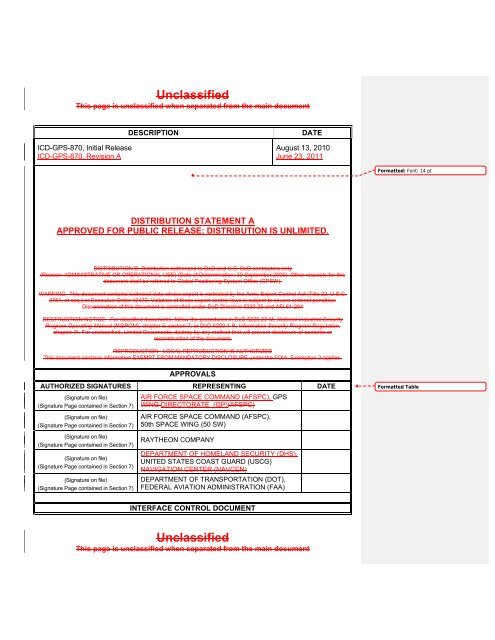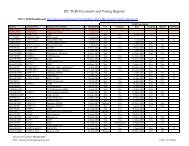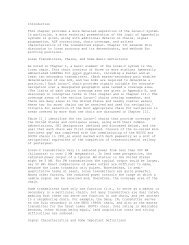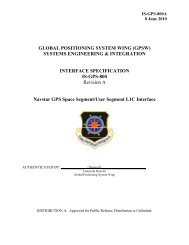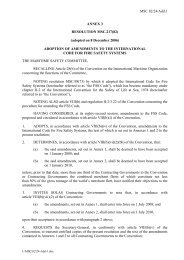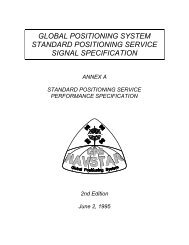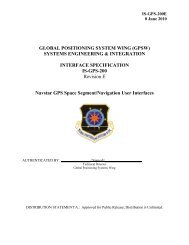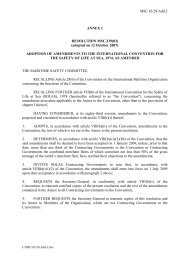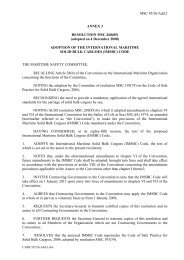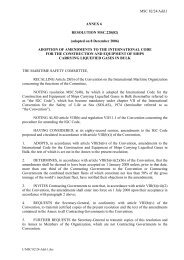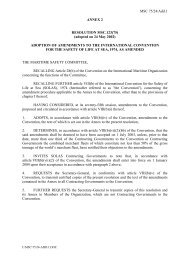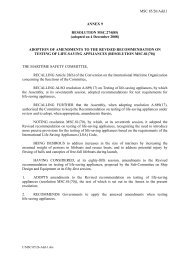ICD-GPS-870 - US Coast Guard Navigation Center
ICD-GPS-870 - US Coast Guard Navigation Center
ICD-GPS-870 - US Coast Guard Navigation Center
- No tags were found...
You also want an ePaper? Increase the reach of your titles
YUMPU automatically turns print PDFs into web optimized ePapers that Google loves.
UnclassifiedThis page is unclassified when separated from the main documentUNLESS OTHERWISE SPECIFIED: NUMBERS AREREPRESENTED IN DECIMAL FORM.THIS DOCUMENT SPECIFIES TECHNICALREQUIREMENTS AND NOTHING HEREIN CONTAINEDSHALL BE DEEMED TO ALTER THE TERMS OF ANYCONTRACT OR PURCHASE ORDER BETWEEN ALLPARTIES AFFECTEDInterface Control Contractor:SAIC <strong>GPS</strong>W SE&I, 300 N. Sepulveda Blvd., Suite 3000El Segundo, CA 90245<strong>ICD</strong> TITLE:Navstar Next Generation <strong>GPS</strong> OperationalControl Segment (OCX) to User SupportCommunity InterfacesSIZE ASCALE: N/AREV: NCACODE IDENT4WNC1<strong>ICD</strong> NO.<strong>ICD</strong>-<strong>GPS</strong>-<strong>870</strong>UnclassifiedThis page is unclassified when separated from the main document
(This page intentionally left blank.)ii<strong>ICD</strong>-<strong>GPS</strong>-<strong>870</strong>13 Aug 201023 June2011
TABLE OF CONTENTS1 SCOPE..................................................................................................................................... 11.1 SCOPE ................................................................................................................................. 11.2 KEY EVENTS ....................................................................................................................... 11.3 INTERFACE CONTROL DOCUMENT APPROVAL AND CHANGES ............................................ 12 APPLICABLE DOCUMENTS ............................................................................................. 32.1 GOVERNMENT DOCUMENTS ............................................................................................... 32.2 NON-GOVERNMENT DOCUMENTS....................................................................................... 43 REQUIREMENTS ................................................................................................................. 53.1 INTERFACE IDENTIFICATION ............................................................................................... 53.1.1 Next Generation <strong>GPS</strong> Operational Control Segment (OCX) ..................................... 63.1.2 <strong>GPS</strong> user and user-support communities .................................................................... 73.2 INTERFACE DEFINITIONS .................................................................................................... 73.2.1 Generation of Almanac Data ...................................................................................... 73.2.2 Generation of Operational Advisory Data .................................................................. 73.2.3 Generation of NANU Data ......................................................................................... 83.2.4 Generation of Anti-Spoofing Status ............................................................................ 83.2.5 Data Distribution ......................................................................................................... 83.2.6 <strong>GPS</strong> MCS to Civil <strong>GPS</strong> Users Interface (<strong>US</strong>CG/FAA) ............................................. 83.2.7 <strong>GPS</strong> MCS to Military <strong>GPS</strong> Users Interface ................................................................ 83.2.8 <strong>GPS</strong> MCS to the United States Notice to Airman Office Interface ............................ 93.3 <strong>GPS</strong> MCS TO <strong>GPS</strong> <strong>US</strong>ER SUPPORT COMMUNITY INFORMATION ASSURANCEREQUIREMENTS ............................................................................................................................ 94 QUALITY ASSURANCE ...................................................................................................... 95 PREPARATION FOR DELIVERY ..................................................................................... 96 NOTES .................................................................................................................................. 106.1 ACRONYMS AND ABBREVIATIONS .................................................................................... 107 APPROVAL .......................................................................................................................... 138 VERIFICATION CROSS REFERENCE MATRIX ........................................................ 148.1 VERIFICATION METHODS .................................................................................................. 1410 APPENDIX 1: NANU DATA FORMATS .................................................................... 7-110.1 NOTICE ADVISORY TO NAVSTAR <strong>US</strong>ERS ...................................................................... 7-110.1.1 Scheduled Outages ................................................................................................... 7-110.1.2 Unscheduled Outages ............................................................................................... 7-610.1.3 General NANU Messages ........................................................................................ 7-810.1.4 Other Messages ........................................................................................................ 7-910.2 NANU NOTIFICATION TIMES ..................................................................................... 7-1310.3 NANU MESSAGE FORMAT ......................................................................................... 7-1410.3.1 NANU Header ....................................................................................................... 7-14iv<strong>ICD</strong>-<strong>GPS</strong>-<strong>870</strong>13 Aug 201023 June2011
10.3.2 NANU Section 1 .................................................................................................... 7-1510.3.2.1 NANU Message Description .................................................................................................................... 7-1610.3.2.2 NANU Reference Information .................................................................................................................. 7-1610.3.2.3 Satellite Identification ............................................................................................................................... 7-1810.3.2.4 Outage Time ............................................................................................................................................. 7-1810.3.3 NANU Section 2 .................................................................................................... 7-2010.3.4 NANU Section 3 .................................................................................................... 7-2020 APPENDIX 2: OPERATIONAL ADVISORY DATA FILE .................................... 20-120.1 OPERATIONAL ADVISORY .......................................................................................... 20-120.2 OA HEADER. .............................................................................................................. 20-320.3 OA SECTION 1 ............................................................................................................ 20-320.4 OA SECTION 2 ............................................................................................................ 20-420.5 OA SECTION 3 ............................................................................................................ 20-530 APPENDIX 3: ALMANAC DATA FILES ................................................................. 30-130.1 ALMANAC DESCRIPTION ............................................................................................ 30-130.2 SEM ALMANAC PARAMETERS DEFINITION ................................................................ 30-130.3 SV HEALTH WORD .................................................................................................... 30-130.4 SEM ALMANAC FORMAT ........................................................................................... 30-330.5 YUMA ALMANAC FORMAT ....................................................................................... 30-740 APPENDIX 4: EXTENDED SIGNALS HEALTH STAT<strong>US</strong> FILES ...................... 40-140.1 EXTENDED SIGNALS HEALTH STAT<strong>US</strong> ........................................................................ 40-150 APPENDIX 5: ANTI-SPOOFING STAT<strong>US</strong> FILE ................................................... 50-150.1 ANTI-SPOOFING STAT<strong>US</strong> ............................................................................................ 50-160 APPENDIX 6: LETTERS OF EXCEPTION ............................................................. 60-160.1 SCOPE ......................................................................................................................... 60-160.2 APPLICABLE DOCUMENTS .......................................................................................... 60-160.3 LETTERS OF EXCEPTION ............................................................................................. 60-1v<strong>ICD</strong>-<strong>GPS</strong>-<strong>870</strong>13 Aug 201023 June2011
TABLE OF FIGURESFigure 1 <strong>GPS</strong> OCX to the <strong>GPS</strong> User Community ............................................................. 5Figure 10-1 FCSTDV NANU Message Template ......................................................... 7-3Figure 10-2 FCSTMX NANU Message Template ......................................................... 7-3Figure 10-3 FCSTEXTD NANU Message Template ..................................................... 7-4Figure 10-4 FCSTSUMM NANU Message Template ................................................... 7-4Figure 10-5 FCSTCANC NANU Message Template .................................................... 7-5Figure 10-6 FCSTRESC NANU Message Template .................................................... 7-5Figure 10-7 FCSTUUFN NANU Message Template .................................................... 7-6Figure 10-8 UN<strong>US</strong>UFN NANU Message Template ...................................................... 7-7Figure 10-9 UN<strong>US</strong>ABLE NANU Message Template .................................................... 7-7Figure 10-10 UNUNOREF NANU Message Template ................................................. 7-8Figure 10-11 General Message Format ........................................................................ 7-9Figure 10-12 <strong>US</strong>ABINIT NANU Message Template ................................................... 7-10Figure 10-13 LEAPSEC NANU Message Template ................................................... 7-11Figure 10-14 LAUNCH NANU Message Template ..................................................... 7-12Figure 10-15 DECOM NANU Message Template ...................................................... 7-12Figure 10-16 NANU Message Template ..................................................................... 7-14Figure 10-17 NANU Header ........................................................................................ 7-15Figure 10-18 Message Description ............................................................................. 7-16Figure 10-19 Reference Information ........................................................................... 7-17Figure 10-20 Satellite Identification Information ......................................................... 7-18Figure 10-21 Outage Time .......................................................................................... 7-19Figure 10-22 NANU Section 2 ..................................................................................... 7-20Figure 10-23 Contact Information ............................................................................... 7-20Figure 20-1 Sample Operational Advisory .................................................................. 20-2Figure 20-2 OA Header ............................................................................................... 20-3Figure 20-3 OA Section 1 ............................................................................................ 20-4Figure 20-4 OA Section 2 ............................................................................................ 20-5Figure 20-5 OA Section 3 ............................................................................................ 20-5Figure 30-1 SEM Data Sample ................................................................................... 30-4Figure 30-2 YUMA Almanac Data Sample For Current.alm ....................................... 30-8Figure 40-1 Extended Signals Health Status Data Sample ........................................ 40-1Figure 50-1 Sample of the Anti-Spoofing status file (as.txt) ....................................... 50-1Figure 60-1 Letter of Exception ................................................................................... 60-2vi<strong>ICD</strong>-<strong>GPS</strong>-<strong>870</strong>13 Aug 201023 June2011
TABLESTable I Information Exchange Matrix ............................................................................... 5Table II Verification Cross Reference Matrix ................................................................. 14Table 10-I Scheduled Outages ..................................................................................... 7-1Table 10-II Unscheduled Outages ................................................................................ 7-6Table 10-III Other Types of NANU Messages .............................................................. 7-9Table 10-IV NANU Notification Times ......................................................................... 7-13Table 30-I Six-Bit SV Health Word in Almanac ........................................................... 30-1Table 30-II SEM Almanac Description for Current.al3 ................................................ 30-5Table 30-III SEM Almanac Description for Current.bl3 ............................................... 30-7Table 40-I Modernized Civil Signals ........................................................................... 40-1Table 40-II ESHS Description ..................................................................................... 40-2vii<strong>ICD</strong>-<strong>GPS</strong>-<strong>870</strong>13 Aug 201023 June2011
1 SCOPE1.1 ScopeThis Interface Control Document (<strong>ICD</strong>) defines the functional data transfer interfacebetween the Next Generation Global Positioning System (<strong>GPS</strong>) Operational ControlSegment (OCX) and the <strong>GPS</strong> user and user-support communities. This <strong>ICD</strong> describesthe data files that are transferred in this interface and the means by which these datafiles are distributed.The files that are distributed by the <strong>GPS</strong> OCX are: Almanacs (SEM, YUMA, andExtended Signals Health Status (ESHS))SEM and YUMA), Operational Advisories(OAs), Anti-Spoofing (A-S) status, and Notice Advisory to Navstar Users (NANUs). Theformat of these files are defined in the Appendices of this document. All datatransferred as described in this <strong>ICD</strong> is unclassified.The <strong>GPS</strong> OCX is operated by the 2 nd Satellite Operations Squadron (2 SOPS),administratively organized under 50 th Space Wing (50 SW). The <strong>GPS</strong> user and usersupportcommunities are comprised of the Department of Homeland Security (DHS)United States <strong>Coast</strong> <strong>Guard</strong> (<strong>US</strong>CG) <strong>Navigation</strong> <strong>Center</strong> (NAVCEN),; Department ofTransportation (DOT), Federal Aviation Administration (FAA), ); other Civil users; andvarious Military <strong>GPS</strong> users. The interfaces between the <strong>GPS</strong> OCX and theNAVCEN<strong>US</strong>CG, FAA, other Civil users, and the <strong>GPS</strong> OCX and the Military <strong>GPS</strong> usercommunity are implemented using electronic mail (e-mail), iInternet andSIPRNETSIPRNet. This <strong>ICD</strong> does not include detailed technical descriptions of the e-mail system, iInternet or SIPRNETSIPRNet.1.2 Key EventsThe major milestone for implementation of this interface is the initial operating capabilityof the <strong>GPS</strong> OCX system beginning with Effectivity 10 as defined in SS-CS-800.1.3 Interface Control Document Approval and ChangesThe Interface Control Contractor (ICC), designated by the government, is responsiblefor the basic preparation, approval, distribution, and retention of the <strong>ICD</strong> in accordancewith the Interface Control Working Group (ICWG) charter GP-03-001.The following signatories must approve this <strong>ICD</strong> to make it effective.1. Air Force Space Command (AFSPC), <strong>GPS</strong> Wing Directorate (<strong>GPS</strong>W) Spaceand Missile Systems <strong>Center</strong> (SMC)2. Department of Homeland Security (DHS), United States <strong>Coast</strong> <strong>Guard</strong>(<strong>US</strong>CG), <strong>Navigation</strong> <strong>Center</strong> (NAVCEN)3. Air Force Space Command (AFSPC), 50 th Space Wing (50 SW)1<strong>ICD</strong>-<strong>GPS</strong>-<strong>870</strong>23 June 201113 Aug2010
4. Department of Transportation (DOT), Federal Aviation Administration (FAA)5. Raytheon Company, OCX ContractorInitial signature approval of this <strong>ICD</strong> can be contingent upon a letter of exceptiondelineating those items by paragraph numbers that are not a part of the approval. Suchletter of exception can be prepared by any of the signatories and must be furnished tothe ICC for inclusion in the printed distribution of the officially released version of the<strong>ICD</strong>.Changes to the approved version of this <strong>ICD</strong> can be initiated by any of the signatoriesand must be approved by all above signatories. The ICC is responsible for thepreparation of the change pages, change coordination, and the change approval by allsignatories. Designated signatories can approve proposed changes to this <strong>ICD</strong> withoutany increase in the scope of a specific contract by so specifying in a letter of exception.Such letters of exception must be furnished to the ICC for inclusion in the releasedversion of the approved change and in the printed distribution of the approved <strong>ICD</strong>.Whenever all of the issues addressed by a letter of exception are resolved, therespective signatory shall so advise the ICC in writing. When a portion of theexceptions taken by a signatory are resolved (but not all), the signatory shall provide theICC with an updated letter of exception. Based on such notifications --– withoutprocessing a proposed interface revision notice (PIRN) for approval --– the ICC will omitthe obsolete letter of exception from the next revision of the <strong>ICD</strong> and will substitute thenew one (if required).The typical review cycle for a PIRN is 45 days after receipt by individual addresseesunless a written request for a waiver is submitted to the ICC.2<strong>ICD</strong>-<strong>GPS</strong>-<strong>870</strong>23 June 201113 Aug2010
2 APPLICABLE DOCUMENTS2.1 Government DocumentsThe following documents of the issue specified contribute to the definition of theinterfaces in this <strong>ICD</strong> and form a part of this <strong>ICD</strong> to the extent specified herein.SpecificationsStandardsFederalNoneMilitaryNoneOther Government ActivitySS-CS-800Current Version<strong>GPS</strong> III Control Segment Specification Global PositioningSystems Wing (<strong>GPS</strong>W)FederalSeptember 2008Global Positioning System Standard Positioning ServicePerformance StandardMilitaryNoneOther PublicationsIS-<strong>GPS</strong>-200Current VersionIS-<strong>GPS</strong>-705Current VersionIS-<strong>GPS</strong>-800Current Version<strong>ICD</strong>-<strong>GPS</strong>-700Current VersionGP-03-001A20 April 2006Navstar <strong>GPS</strong> Space Segment / <strong>Navigation</strong> User InterfaceNavstar <strong>GPS</strong> Space Segment / User Segment L5 InterfacesNavstar <strong>GPS</strong> Space Segment / User Segment L1CInterfacesNavstar <strong>GPS</strong> Military-Unique Space Segment / UserSegment Interfaces<strong>GPS</strong> Interface Control Working Group (ICWG) Charter3<strong>ICD</strong>-<strong>GPS</strong>-<strong>870</strong>23 June 201113 Aug2010
MOAFebruary 1992MOAFebruary 1996MOAFebruary 2010Fiscal Year 2008Memorandum of Agreement Between the United States<strong>Coast</strong> <strong>Guard</strong> and the United States Space Command,“Distribution of Navstar Global Positioning System (<strong>GPS</strong>)Status Information”(Signatories: <strong>US</strong>CG/G-NRN and <strong>US</strong>SPACECOM/DO)Support Agreement Between the United States <strong>Coast</strong><strong>Guard</strong> and the United States Air Force Space Command,“Distribution of Navstar Global Positioning System (<strong>GPS</strong>)Status Information”(Signatories: Commanding Officer NAVCEN andAFSPC/DO)Memorandum of Agreement between the Joint FunctionalComponent Command for Space the U.S. <strong>Coast</strong> <strong>Guard</strong><strong>Navigation</strong> <strong>Center</strong> and the FAA National Operations Control<strong>Center</strong> with respect to the Support of Users of the NavstarGlobal Positioning SystemFederal Radionavigation Plan2.2 Non-Government DocumentsThe following documents of the issue specified contribute to the definition of theinterfaces in this <strong>ICD</strong> and form a part of this <strong>ICD</strong> to the extent specified herein.SpecificationsNoneStandardsNoneOther PublicationsNone4<strong>ICD</strong>-<strong>GPS</strong>-<strong>870</strong>23 June 201113 Aug2010
3 REQUIREMENTS3.1 Interface IdentificationThis <strong>ICD</strong> defines the interfaces between the Next Generation Global Positioning System(<strong>GPS</strong>) Operational Control Segment (OCX) and the <strong>GPS</strong> user and user-supportcommunities during the OCX era. The files provided by the <strong>GPS</strong> OCX to these <strong>GPS</strong>Users are the Almanacs, Operational Advisories (OasOAs), Anti-Spoofing (A-S) status,and the Notice Advisory to Navstar Users (NANUs) files corresponding to all legacysignals and the new signals L1C, L2C, L5, and M-Code. The primary means fordistribution of the data that is generated by the <strong>GPS</strong> OCX is via electronic mail (e-mail),iInternet and SIPRNetET.Figure 1 captures the interfaces defined in this <strong>ICD</strong>.MCS/AMCSUsersAutomatic NANUnotification sent via e-mailAlmanacs, NANUs,OAs, and A-S files viaOCX InternetWebsiteInternetDHS <strong>US</strong>CG/DOT FAA/Other Civil UsersOCX Secure NetworkEnvironmentAlmanacs , NANUs,OAs, and A-SAlmanacs, NANUs,OAs, and A-S filesvia OCX SIPRNetWebsiteSIPRNetMilitary <strong>GPS</strong> UserCommunitySAFB/VAFBFigure 1 <strong>GPS</strong> OCX to the <strong>GPS</strong> User CommunityThe interfaces defined in this <strong>ICD</strong> are listed in Table ITable I, in the form of aninformation exchange matrix.Table I Information Exchange MatrixProducer Consumer Data ExchangeIdentificationInformationDescriptionNature ofTransactionSecurity<strong>GPS</strong> OCX DHS <strong>US</strong>CGNAVCEN/DOT FAA/Other CivilUsers*<strong>GPS</strong> StatusInformationNANUTransmit viaE-Mail and Post toInternet WebsiteUnclassified5<strong>ICD</strong>-<strong>GPS</strong>-<strong>870</strong>23 June 201113 Aug2010
Producer Consumer Data ExchangeIdentification<strong>GPS</strong> OCX DHS <strong>US</strong>CGNAVCEN/DOT FAA/Other CivilUsers<strong>GPS</strong> OCX DHS <strong>US</strong>CG /DOT FAA/Other CivilUsers<strong>GPS</strong> OCX DHS <strong>US</strong>CGNAVCEN/DOT FAA/Other CivilUsers<strong>GPS</strong> OCX Military UserCommunity<strong>GPS</strong> OCX Military UserCommunity<strong>GPS</strong> OCX Military UserCommunity<strong>GPS</strong> OCX Military UserCommunity<strong>GPS</strong> ConstellationStatus Summary<strong>GPS</strong> ConstellationStatus Summary<strong>GPS</strong> ConstellationOrbital andPerformanceParameters, andSV Signal HealthStatus<strong>GPS</strong> StatusInformation<strong>GPS</strong> ConstellationStatus Summary<strong>GPS</strong> ConstellationStatus Summary<strong>GPS</strong> ConstellationOrbital andPerformanceParameters, andSV Signal HealthStatusInformationDescriptionOAA-SAlmanacNANUOAA-SAlmanacNature ofTransactionPost to InternetWebsitePost to InternetWebsitePost to InternetWebsitePost to Internetand SIPRNetETWebsitesPost to Internetand SIPRNetETWebsitesPost to Internetand SIPRNetWebsitesPost to Internetand SIPRNetETWebsitesSecurityUnclassifiedUnclassifiedUnclassifiedUnclassifiedUnclassifiedUnclassifiedUnclassifiedNote:* Automatic NANUs are also sent to other 2 SOPS approved .mil and .gov users via e-mail3.1.1 Next Generation <strong>GPS</strong> Operational Control Segment (OCX)The <strong>GPS</strong> OCX is operated by the 2 nd Satellite Operations Squadron (2 SOPS),administratively organized under 50 th Space Wing (50 SW). The <strong>GPS</strong> OCX operationsare performed primarily via the Master Control Station (MCS), Alternate Master ControlStation (AMCS), Monitor Stations (MS), and Ground Antennas (GA).The MCS, located at Schriever Air Force Base (SAFB), is the central control point forthe <strong>GPS</strong> OCX. For this interface, the MCS is responsible for generating the Aalmanacs,OasOAs, A-S status and NANUs and providing these files to the <strong>GPS</strong> users and usersupport community. The AMCS, located at Vandenberg AFB (VAFB), is functionallyidentical to the MCS; either MCS facility is capable of indefinite control of the <strong>GPS</strong>constellation. In case the MCS experiences downtime, the AMCS takes over this6<strong>ICD</strong>-<strong>GPS</strong>-<strong>870</strong>23 June 201113 Aug2010
interface function. The term “MCS”, as now used throughout this document, refers toeither the MCS or the AMCS, whichever MCS facility actively controls the <strong>GPS</strong>constellation.The MSs and Gas GAs do not play a role in this interface.3.1.2 <strong>GPS</strong> user and user-support communitiesThe <strong>GPS</strong> user and user-support communities involve the Civil and Military <strong>GPS</strong> userswhich are comprised of the Department of Homeland Security (DHS), United States<strong>Coast</strong> <strong>Guard</strong> (<strong>US</strong>CG); <strong>Navigation</strong> <strong>Center</strong> (NAVCEN), Department of Transportation(DOT), Federal Aviation Administration (FAA),; other Civil Users; and various Military<strong>GPS</strong> uUsers. These <strong>GPS</strong> Users are the recipients of the aAlmanac data, OasOAs, A-Sstatus and NANUs.3.2 Interface DefinitionsThe following subsections define the functional requirements and physical interfacebetween the <strong>GPS</strong> OCX and the DHS <strong>US</strong>CG NAVCEN, DOT FAA, other Civil Users, andthe Military <strong>GPS</strong> uUser cCommunity. For this interface, the <strong>GPS</strong> OCX will communicateusing Transmission Control Protocol/Internet Protocol (TCP/IP) communicationsprotocol.This <strong>ICD</strong> describes information exchanges between OCX and the user supportcommunity at the functional (application) layer only, and does not describe the hardwareand software configuration of the Internet or SIPRNetET.3.2.1 Generation of Almanac DataThe <strong>GPS</strong> OCX generates the Almanac data for the <strong>GPS</strong> constellation, one two currentSystem Effectiveness Model (SEM) format aAlmanac (current.al3 and current.bl3), andone two current YUMA format aAlmanac (current.alm and current.blm), and one currentExtended Signals Health Status (ESHS) format Almanac (current.ale). The satelliteSEM and YUMA aAlmanac data contains orbital and performance parameters foroperational <strong>GPS</strong> satellites. Detailed data formats of the SEM and YUMA aAlmanacdata are described in Appendix 3 of this <strong>ICD</strong>. The satellite ESHS Almanac datacontains the health status of each of the modernized civil signals available for each SV– L1C, L2C and L5. Detailed data formats of the ESHS Almanac data are described inAppendix 4 of this <strong>ICD</strong>.3.2.2 Generation of Operational Advisory DataThe <strong>GPS</strong> OCX generates the Operational Advisory data (current.oa1) for the <strong>GPS</strong>constellation. The OA data are descriptive summaries of <strong>GPS</strong> constellation status.Detailed data formats of the OA data are described in Appendix 2 of this <strong>ICD</strong>.7<strong>ICD</strong>-<strong>GPS</strong>-<strong>870</strong>23 June 201113 Aug2010
3.2.3 Generation of NANU DataThe <strong>GPS</strong> OCX generates the NANU data file (current.nnu) for the <strong>GPS</strong> constellation.The NANU data are messages that inform users of satellite outages and other <strong>GPS</strong>issues. Detailed data formats of the NANU data are described in Appendix 1 of this<strong>ICD</strong>.3.2.4 Generation of Anti-Spoofing StatusThe <strong>GPS</strong> OCX generates the Anti-Spoofing status files (as.txt and as2.txt) for the <strong>GPS</strong>constellation. The A-S status informs Users whether the Anti-Spoofing mode of each<strong>GPS</strong> SV is ON or OFF. Detailed data format of the A-S status are described inAppendix 5 of this <strong>ICD</strong>.3.2.43.2.5 Data DistributionThe <strong>GPS</strong> OCX distributes the NANU, Operational Advisory, Anti-Spoofing status, andSatellite Almanac files to the Military and Civil User Support Communities via electronicmail (e-mail), and iInternet and SIPRNetET websites. Sections 3.2.5 6 and 3.2.6 7describe these interfaces.3.2.53.2.6 <strong>GPS</strong> MCS to Civil <strong>GPS</strong> Users Interface (NAVCEN<strong>US</strong>CG/FAA)The <strong>GPS</strong> OCX provides the NANU data file via automatic electronic mail (e-mail)distribution to an e-mail address provided by the <strong>US</strong>CGNAVCEN and FAA. E-mail usedfor data transfer is generated and transmitted using resources of the OCX securenetwork environment. Other approved/authorized <strong>GPS</strong> users with .mil or .gov e-mailaccounts also receive automatic NANUs. Automatic e-mail distribution implies thatOCX will maintain a distribution list of approved e-mail addresses.The <strong>GPS</strong> OCX uploads the NANU, Operational Advisory, Anti-Spoofing status, andSatellite Almanac files to the Constellation Status page of the 2 nd Space OperationsSquadron (2 SOPS) iInternet secured website, https://gps.afspc.af.mil/gps. NANUmessages are transmitted whenever they are generated including weekends andholidays. An OA data file is normally uploaded to the 2 SOPS internet website once perday, 24/7, 365 days a year, prior to 1700 Zulu time (10 am MST, 11 am MDT). The OA,A-S status, and Almanac files are normally uploaded to the 2 SOPS iInternet websiteonce per day, 24/7, 365 days a year, prior to 1700 Zulu time (10 am MST, 11 am MDT).Internet website hosting, uploads, and downloads are also accomplished usingresources of the OCX secure network environment. The <strong>US</strong>CGNAVCEN, FAA andother <strong>GPS</strong> users, including Military users and the general public, with iInternetconnectivity can access the 2 SOPS website and download these data files usingHypertext Transfer Protocol Secure (HTTPS)File Transfer Protocol (FTP).3.2.63.2.7 <strong>GPS</strong> MCS to Military <strong>GPS</strong> Users InterfaceThe Military <strong>GPS</strong> users with iInternet connectivity can access the 2 SOPS securediInternet website and download NANU, Operational Advisory, Anti-Spoofing status, andSatellite Almanac files as described in Section 3.2.56.8<strong>ICD</strong>-<strong>GPS</strong>-<strong>870</strong>23 June 201113 Aug2010
The <strong>GPS</strong> OCX uploads the NANU, Operational Advisory, Anti-Spoofing status, andSatellite Almanac files to the 2 SOPS SIPRNetET website with the same frequency andtimeline as for the Internet website as described in Section 3.2.56. SIPRNetET websitehosting, uploads, and downloads are accomplished using resources of the OCX securenetwork environment. Only authorized Military <strong>GPS</strong> users with SIPRNet connectivitycan download a NANU, OA, or aAlmanac data file using FTPHTTPS.3.2.73.2.8 <strong>GPS</strong> MCS to the United States Notice to Airman Office InterfaceThere is a data transfer interface between the CS and the United States NOTAM(Notice to Airmen) Office (<strong>US</strong>NOF) which is similar in content to the CS interface withthe NAVCEN <strong>US</strong>CG and FAA. However, at this time, the CS to <strong>US</strong>NOF interface isdefined and controlled by operational procedures and is not automated. Therefore, it isnot included in this <strong>ICD</strong>. It is expected that a new automated interface between the CSand the <strong>US</strong>NOF will be added to this <strong>ICD</strong> in a future revision.3.3 <strong>GPS</strong> MCS to <strong>GPS</strong> User Support Community Information AssuranceRequirements<strong>GPS</strong> OCX will sign all <strong>ICD</strong>-<strong>GPS</strong>-<strong>870</strong> information with a DoD Public Key Infrastructure(PKI) provided certificate specific for this purpose. This will ensure that the informationprovided by this interface is genuine and originates from the <strong>GPS</strong> MCS.The OCX certificate (and corresponding public key) will be made available to all usersfor data integrity verification and source authentication. DoD PKI root certificates areavailable on the DoD Class 3 Public Key Infrastructure (PKI) website,http://dodpki.c3pki.chamb.disa.mil/, to verify the certificate chain.4 QUALITY ASSURANCENot Applicable5 PREPARATION FOR DELIVERYNot Applicable9<strong>ICD</strong>-<strong>GPS</strong>-<strong>870</strong>23 June 201113 Aug2010
6 NOTES6.1 Acronyms and Abbreviations2 SOPS 2 nd Space Operations Squadron50 SW 50 th Space WingA-SAnti-SpoofingAEPArchitecture Evolution PlanAFAir ForceAFBAir Force BaseAFSPC Air Force Space CommandAMCSAlternate Master Control StationANOMAnomalyASCIIAmerican Standard Code for Information InterchangeCOMMCommercialCSControl Segment, CesiumDECOM DecommissionDHSDepartment of Homeland SecurityDODirector of OperationsDODDepartment of DefenseDOTDepartment of TransportationDSNDefense Switched NetworkDTGDay Time Groupe-mailElectronic mailESHSExtended Signals Health StatusFAAFederal Aviation AdministrationFCSTCANC Forecast CancellationFCSTDV Forecast Delta-VFCSTEXTD Forecast ExtensionFCSTMX Forecast MaintenanceFCSTRESCD Forecast rescheduledFCSTSUMM Forecast SummaryFCSTUUFN Forecast Unusable Until Further NoticeFTPFile Transfer ProtocolG-NRNRadio <strong>Navigation</strong> DivisionGAGround AntennaGPGlobal Positioning System Directorate<strong>GPS</strong>Global Positioning System<strong>GPS</strong>OC <strong>GPS</strong> Operations <strong>Center</strong>HTTPSHypertext Transfer Protocol Secure10<strong>ICD</strong>-<strong>GPS</strong>-<strong>870</strong>23 June 201113 Aug2010
ICC<strong>ICD</strong>ICWGIDIPISJDAYLEAPSECLSBMMDTMCSMOAMSMSTN/ANANUNAVNAVCENNCNOTAMOAOCSOCXPIRNPKIPRNPOCRBsSAFBSAICSE&ISEMSIPRNetETSMCSQRTSUBJSVInterface Control ContractorInterface Control DocumentInterface Control Working GroupIdentificationInternet ProtocolInterface SpecificationJulian Day of the YearLeap SecondLeast Significant BitMetersMountain Daylight TimeMaster Control StationMemorandum of AgreementMonitor StationMountain Standard TimeNot ApplicableNotice Advisory to Navstar Users<strong>Navigation</strong><strong>Navigation</strong> <strong>Center</strong>No ChangeNotice to AirmenOperational AdvisoryOperational Control SegmentNext Generation <strong>GPS</strong> Operational Control SegmentProposed Interface Revision NoticePublic Key InfrastructurePseudorandom Noise (Signal Number)Point Of ContactRubidiumSecondsSchriever Air Force BaseScience Applications International CorporationSystems Engineering and IntegrationSystem Effectiveness ModelSecret Internet Protocol Router NetworkSpace and Missile Systems <strong>Center</strong>Square RootSubjectSpace Vehicle11<strong>ICD</strong>-<strong>GPS</strong>-<strong>870</strong>23 June 201113 Aug2010
SVIDSVNSWTCPURA<strong>US</strong>ABINIT<strong>US</strong>CG<strong>US</strong>NOFUNUNOREFUN<strong>US</strong>ABLEUN<strong>US</strong>UFN<strong>US</strong>SPACECOMVAFBWNSpace Vehicle IdentificationSpace Vehicle NumberSpace WingTransmission Control ProtocolUser Range AccuracyInitially usableUnited States <strong>Coast</strong> <strong>Guard</strong>United States Notice to Airmen OfficeUnusable with no referenceUnusable with reference NANUUnusable Until Further NoticeUnited States Space CommandVandenberg Air Force BaseWeek Number12<strong>ICD</strong>-<strong>GPS</strong>-<strong>870</strong>23 June 201113 Aug2010
7 APPROVALThe signatories have approved this <strong>ICD</strong> with or without exception as their signatureblock implies and a copy of each approval sheet is included in this section.13<strong>ICD</strong>-<strong>GPS</strong>-<strong>870</strong>23 June 201113 Aug2010
8 VERIFICATION CROSS REFERENCE MATRIXThe verification cross reference matrix (VCRM), Table II, identifies the verificationmethod planned for each requirement in this interface.8.1 Verification MethodsFour standard verification methods are planned for this interface, as described in theSS-CS-800 Specification, Section 4. The descriptions of these methods are includedbelow.Inspection – Verifies conformance of physical characteristics to related requirementswithout the aid of special laboratory equipment, procedures, and services. This methodmost commonly uses an examination by the senses (sight, sound, smell, taste, ortouch) to determine requirements compliance and may also rely on gauges or simplemeasures.Analysis – Verifies conformance to requirements based on studies, calculations, andmodeling, or is based on the certified usage of similar components under identical orsimilar operating conditions (similarity). This method may consist of the technicalevaluation of data using logic or mathematics to determine compliance withrequirements. It is typically used in verification when a given attribute is impossible orextremely difficult to test, thereby enabling expansion of the verification beyond therange of the test. Review of Software listings is considered to be Verification byAnalysis. Software code review or inspection is also considered analysis verification.Demonstration – Verifies the required operability of hardware and software by meansthat do not necessarily require the use of laboratory equipment, procedures, items orservices. That is, compliance with requirements is verified by operation and function.More detail may be seen in MIL-HDBK-470 and MIL-STD-810. This method may be anun-instrumented test, with compliance determined by observation (e.g., maintenancetask performance time).Test – Verifies conformance to required performance/physical characteristics anddesign/construction features by instrumented functional operation and evaluationtechniques through the use of laboratory equipment procedures, items, and services.This method generally uses procedures and test/measuring equipment to verifycompliance with requirements.Section#Table II Verification Cross Reference MatrixRequirement TitleVerificationMethodVerificationLevel3.2 Interface Definition Demonstration Segment14<strong>ICD</strong>-<strong>GPS</strong>-<strong>870</strong>23 June 201113 Aug2010
Section#Requirement TitleVerificationMethodVerificationLevel3.2.1 Generation of Almanac Data Demonstration Segment3.2.2 Generation of Operational Advisory Data Demonstration Segment3.2.3 Population of NANU Data Demonstration Segment3.2.4 Generation of Anti Spoofing Status Demonstration Segment3.2.45 Data Distribution Demonstration Segment3.2.56 <strong>GPS</strong> MCS to Civil <strong>GPS</strong> Users InterfaceDemonstration Segment(NAVCEN<strong>US</strong>CG/FAA)3.2.67 <strong>GPS</strong> MCS to Military <strong>GPS</strong> Users Interface Demonstration Segment3.2.8 <strong>GPS</strong> MCS to the United States Notice to N/A*N/A*Airman Office Interface3.3 <strong>GPS</strong> MCS to <strong>GPS</strong> User Support CommunityInformation Assurance RequirementsDemonstration Segment* No verifiable requirements in this section.15<strong>ICD</strong>-<strong>GPS</strong>-<strong>870</strong>23 June 201113 Aug2010
10 APPENDIX 1: NANU DATA FORMATSAppendix 1 describes the NANU types and the NANU message format.that are used in the OCS/AEP era. The next revision of this <strong>ICD</strong> (Rev A) will contain theOCX NANU data formats which will account for the increase in SV constellation and theinclusion of the <strong>GPS</strong> III fleet during the OCX era.10.1 Notice Advisory to Navstar UsersNANUs are used to notify users of scheduled and unscheduled satellite outages andgeneral <strong>GPS</strong> information. The paragraphs that follow describe the different types ofNANUs. The NANU descriptions are arranged into four groups, as follows:• Scheduled outages• Unscheduled outages• General text message• Others10.1.1 Scheduled OutagesNANU types in the scheduled outage group forecast outages that are planned to beginin the near future. Table 10-ITable 10-I identifies NANU types in the scheduled outagegroup. The table describes the NANU acronym used in the message format, the nameof the file and a description of the outages. NANU acronyms in this group all begin with“FCST” for “forecast.”Table 10-I Scheduled OutagesNANUACRONYMNAMEDESCRIPTIONFCSTDV Forecast Delta-V Scheduled outage times for Delta-V maneuvers.FCSTMXFCSTEXTDFCSTSUMMFCSTCANCFCSTRESCDForecastMaintenanceForecastExtensionForecastSummaryForecastCancellationForecastrescheduledScheduled outage times for non-Delta-V maintenance.Extends the scheduled outage time “Until FurtherNotice”; references the original forecast NANU.Exact outage times for the scheduled outage. This issent after the maintenance is complete and the satelliteis set healthy. It references the original forecast NANU.If a FCSTEXTD or a FCSTRESCD were required theFCSTSUMM will reference these.Cancels a scheduled outage when a new maintenancetime is not yet determined; it references the originalforecast NANU message.Reschedules a scheduled outage referencing theoriginal-FCST NANU message.10-1<strong>ICD</strong>-<strong>GPS</strong>-<strong>870</strong>23 June 201113 Aug2010
NANUACRONYMNAMEDESCRIPTIONFCSTUUFNForecast UnusableUntil FurtherNoticeScheduled outage of indefinite duration not necessarilyrelated to Delta-V or maintenance activities.10-2<strong>ICD</strong>-<strong>GPS</strong>-<strong>870</strong>23 June 201113 Aug2010
The message templates for the NANU types listed in Table 10-I are shown in Figures10-1 through 10-7, respectively.NOTICE ADVISORY TO NAVSTAR <strong>US</strong>ERS (NANU) YYYYSSSSUBJ: SVNXXX (PRNXX) FORECAST OUTAGE JDAY JJJ/HHMM - JDAY JJJ/HHMM1. NANU TYPE: FCSTDVNANU NUMBER: YYYYSSSNANU DTG: DDHHMMZ MMM YYYYREFERENCE NANU: N/AREF NANU DTG: N/ASVN: XXXPRN: XXSTART JDAY: JJJSTART TIME ZULU: HHMMSTART CALENDAR DATE: DD MMM YYYYSTOP JDAY: JJJSTOP TIME ZULU: HHMMSTOP CALENDAR DATE: DD MMM YYYY2. CONDITION: <strong>GPS</strong> SATELLITE SVNXXX (PRNXX) WILL BE UN<strong>US</strong>ABLE ON JDAY JJJ(DD MMM YYYY) BEGINNING HHMM ZULU UNTIL JDAY JJJ (DD MMM YYYY) ENDING HHMM ZULU.3. POC: CIVILIAN - NAVCEN AT 703-313-5900, HTTP://WWW.NAVCEN.<strong>US</strong>CG.GOVCIVIL AVIATION - TBDMILITARY - <strong>GPS</strong> Support <strong>Center</strong> at HTTPS://<strong>GPS</strong>.AFSPC.AF.MIL/<strong>GPS</strong>OC, DSN 560-2541,COMM 719-567-2493, <strong>GPS</strong>_SUPPORT@SCHRIEVER.AF.MIL, HTTP://WWW.SCHRIEVER.AF.MIL/<strong>GPS</strong>MILITARY ALTERNATE - JOINT SPACE OPERATIONS CENTER, DSN 276-9994.COMM 805-606-9994, JSPOCCOMBATOPS@VANDENBERG.AF.MILFigure 10-1 FCSTDV NANU Message TemplateNOTICE ADVISORY TO NAVSTAR <strong>US</strong>ERS (NANU) YYYYSSSSUBJ: SVNXXX (PRNXX) FORECAST OUTAGE JDAY JJJ/HHMM - JDAY JJJ/HHMM1. NANU TYPE: FCSTMXNANU NUMBER: YYYYSSSNANU DTG: DDHHMMZ MMM YYYYREFERENCE NANU: N/AREF NANU DTG: N/ASVN: XXXPRN: XXSTART JDAY: JJJSTART TIME ZULU: HHMMSTART CALENDAR DATE: DD MMM YYYYSTOP JDAY: JJJSTOP TIME ZULU: HHMMSTOP CALENDAR DATE: DD MMM YYYY2. CONDITION: <strong>GPS</strong> SATELLITE SVNXXX (PRNXX) WILL BE UN<strong>US</strong>ABLE ON JDAY JJJ(DD MMM YYYY) BEGINNING HHMM ZULU UNTIL JDAY JJJ (DD MMM YYYY)ENDING HHMM ZULU.3. POC: CIVILIAN - NAVCEN AT 703-313-5900, HTTP://WWW.NAVCEN.<strong>US</strong>CG.GOVCIVIL AVIATION - TBDMILITARY - <strong>GPS</strong> Support <strong>Center</strong> at HTTPS://<strong>GPS</strong>.AFSPC.AF.MIL/<strong>GPS</strong>OC, DSN 560-2541,COMM 719-567-2493, <strong>GPS</strong>_SUPPORT@SCHRIEVER.AF.MIL, HTTP://WWW.SCHRIEVER.AF.MIL/<strong>GPS</strong>MILITARY ALTERNATE - JOINT SPACE OPERATIONS CENTER, DSN 276-9994.COMM 805-606-9994, JSPOCCOMBATOPS@VANDENBERG.AF.MILFigure 10-2 FCSTMX NANU Message Template10-3<strong>ICD</strong>-<strong>GPS</strong>-<strong>870</strong>23 June 201113 Aug2010
NOTICE ADVISORY TO NAVSTAR <strong>US</strong>ERS (NANU) YYYYSSSSUBJ: SVNXXX (PRNXX) FORECAST OUTAGE EXTENDED UNTIL FURTHER NOTICE1. NANU TYPE: FCSTEXTDNANU NUMBER: YYYYSSSNANU DTG: DDHHMMZ MMM YYYYREFERENCE NANU: YYYYNNNREF NANU DTG: DDHHMMZ MMM YYYYSVN: XXXPRN: XXSTART JDAY: JJJSTART TIME ZULU: HHMMSTART CALENDAR DATE: DD MMM YYYYSTOP JDAY: UFNSTOP TIME ZULU: N/ASTOP CALENDAR DATE: N/A2. CONDITION: THE FORECAST OUTAGE FOR <strong>GPS</strong> SATELLITE SVNXXX (PRNXX) IS EXTENDED UNTILFURTHER NOTICE.3. POC: CIVILIAN - NAVCEN AT 703-313-5900, HTTP://WWW.NAVCEN.<strong>US</strong>CG.GOVCIVIL AVIATION - TBDMILITARY - <strong>GPS</strong> Support <strong>Center</strong> at HTTPS://<strong>GPS</strong>.AFSPC.AF.MIL/<strong>GPS</strong>OC, DSN 560-2541,COMM 719-567-2493, <strong>GPS</strong>_SUPPORT@SCHRIEVER.AF.MIL, HTTP://WWW.SCHRIEVER.AF.MIL/<strong>GPS</strong>MILITARY ALTERNATE - JOINT SPACE OPERATIONS CENTER, DSN 276-9994.COMM 805-606-9994, JSPOCCOMBATOPS@VANDENBERG.AF.MILFigure 10-3 FCSTEXTD NANU Message TemplateNOTICE ADVISORY TO NAVSTAR <strong>US</strong>ERS (NANU) YYYYSSSSUBJ: SVNXXX (PRNXX) FORECAST OUTAGE SUMMARY JDAY JJJ/HHMM - JDAY JJJ/HHMM1. NANU TYPE: FCSTSUMMNANU NUMBER: YYYYSSSNANU DTG: DDHHMMZ MMM YYYYREFERENCE NANU: YYYYNNNREF NANU DTG: DDHHMMZ MMM YYYYSVN: XXXPRN: XXSTART JDAY: JJJSTART TIME ZULU: HHMMSTART CALENDAR DATE: DD MMM YYYYSTOP JDAY: JJJSTOP TIME ZULU: HHMMSTOP CALENDAR DATE: DD MMM YYYY2. CONDITION: <strong>GPS</strong> SATELLITE SVNXXX (PRNXX) WAS UN<strong>US</strong>ABLE ON JDAY JJJ(DD MMM YYYY) BEGINNING HHMM ZULU UNTIL JDAY JJJ (DD MMM YYYY)ENDING HHMM ZULU.3. POC: CIVILIAN - NAVCEN AT 703-313-5900, HTTP://WWW.NAVCEN.<strong>US</strong>CG.GOVCIVIL AVIATION - TBDMILITARY - <strong>GPS</strong> Support <strong>Center</strong> at HTTPS://<strong>GPS</strong>.AFSPC.AF.MIL/<strong>GPS</strong>OC, DSN 560-2541,COMM 719-567-2493, <strong>GPS</strong>_SUPPORT@SCHRIEVER.AF.MIL, HTTP://WWW.SCHRIEVER.AF.MIL/<strong>GPS</strong>MILITARY ALTERNATE - JOINT SPACE OPERATIONS CENTER, DSN 276-9994.COMM 805-606-9994, JSPOCCOMBATOPS@VANDENBERG.AF.MILFigure 10-4 FCSTSUMM NANU Message Template10-4<strong>ICD</strong>-<strong>GPS</strong>-<strong>870</strong>23 June 201113 Aug2010
NOTICE ADVISORY TO NAVSTAR <strong>US</strong>ERS (NANU) YYYYSSSSUBJ: SVNXXX (PRNXX) FORECAST OUTAGE CANCELLED1. NANU TYPE: FCSTCANCNANU NUMBER: YYYYSSSNANU DTG: DDHHMMZ MMM YYYYREFERENCE NANU: YYYYNNNREF NANU DTG: DDHHMMZ MMM YYYYSVN: XXXPRN: XXSTART JDAY: JJJSTART TIME ZULU: HHMMSTART CALENDAR DATE: DD MMM YYYYSTOP JDAY: CANCELLEDSTOP TIME ZULU: N/ASTOP CALENDAR DATE: N/A2. CONDITION: THE FORECAST OUTAGE FOR <strong>GPS</strong> SATELLITE SVNXXX (PRNXX) SCHEDULED FORJDAY JJJ (DD MMM YYYY) BEGINNING HHMM ZULU HAS BEEN CANCELLED.3. POC: CIVILIAN - NAVCEN AT 703-313-5900, HTTP://WWW.NAVCEN.<strong>US</strong>CG.GOVCIVIL AVIATION - TBDMILITARY - <strong>GPS</strong> Support <strong>Center</strong> at HTTPS://<strong>GPS</strong>.AFSPC.AF.MIL/<strong>GPS</strong>OC, DSN 560-2541,COMM 719-567-2493, <strong>GPS</strong>_SUPPORT@SCHRIEVER.AF.MIL, HTTP://WWW.SCHRIEVER.AF.MIL/<strong>GPS</strong>MILITARY ALTERNATE - JOINT SPACE OPERATIONS CENTER, DSN 276-9994.COMM 805-606-9994, JSPOCCOMBATOPS@VANDENBERG.AF.MILFigure 10-5 FCSTCANC NANU Message TemplateNOTICE ADVISORY TO NAVSTAR <strong>US</strong>ERS (NANU) YYYYSSSSUBJ: SVNXXX (PRNXX) FORECAST OUTAGE RESCHEDULED1. NANU TYPE: FCSTRESCDNANU NUMBER: YYYYSSSNANU DTG: DDHHMMZ MMM YYYYREFERENCE NANU: YYYYNNNREF NANU DTG: DDHHMMZ MMM YYYYSVN: XXXPRN: XXSTART JDAY: JJJSTART TIME ZULU: HHMMSTART CALENDAR DATE: DD MMM YYYYSTOP JDAY: JJJSTOP TIME ZULU: HHMMSTOP CALENDAR DATE: DD MMM YYYY2. CONDITION: <strong>GPS</strong> SATELLITE SVNXXX (PRNXX) WILL BE UN<strong>US</strong>ABLE ON JDAY JJJ(DD MMM YYYY) BEGINNING HHMM ZULU UNTIL JDAY JJJ (DD MMM YYYY)ENDING HHMM ZULU. PLEASE REFERENCE NANU NUMBER YYYYNNNDTG DDHHMMZ MMM YYYY FOR THE ORIGINAL OUTAGE TIME.3. POC: CIVILIAN - NAVCEN AT 703-313-5900, HTTP://WWW.NAVCEN.<strong>US</strong>CG.GOVCIVIL AVIATION - TBDMILITARY - <strong>GPS</strong> Support <strong>Center</strong> at HTTPS://<strong>GPS</strong>.AFSPC.AF.MIL/<strong>GPS</strong>OC, DSN 560-2541,COMM 719-567-2493, <strong>GPS</strong>_SUPPORT@SCHRIEVER.AF.MIL, HTTP://WWW.SCHRIEVER.AF.MIL/<strong>GPS</strong>MILITARY ALTERNATE - JOINT SPACE OPERATIONS CENTER, DSN 276-9994.COMM 805-606-9994, JSPOCCOMBATOPS@VANDENBERG.AF.MILFigure 10-6 FCSTRESC NANU Message Template10-5<strong>ICD</strong>-<strong>GPS</strong>-<strong>870</strong>23 June 201113 Aug2010
NOTICE ADVISORY TO NAVSTAR <strong>US</strong>ERS (NANU) YYYYJJJSUBJ: SVNXXX (PRNXX) FORECAST OUTAGE SUMMARY JDAY JJJ/HHHH - UFN1. NANU TYPE: FCSTUUFNNANU NUMBER: YYYYSSSNANU DTG: HHHHDDZ MMM YYYYSVN: XXXPRN: XXSTART JDAY: JJJSTART TIME ZULU: HHHHSTART CALENDAR DATE: DD MMM YYYY2. CONDITION: <strong>GPS</strong> SATELLITE SVNXXX (PRNXX) WAS UN<strong>US</strong>ABLE ON JDAY 211(30 JUL 2009) BEGINNING 0915 ZULU UNTIL FURTHER NOTICE.3. POC: CIVILIAN - NAVCEN AT 703-313-5900, HTTP://WWW.NAVCEN.<strong>US</strong>CG.GOVCIVIL AVIATION - TBDMILITARY - <strong>GPS</strong> Support <strong>Center</strong> at HTTPS://<strong>GPS</strong>.AFSPC.AF.MIL/<strong>GPS</strong>OC, DSN 560-2541,COMM 719-567-2493, <strong>GPS</strong>_SUPPORT@SCHRIEVER.AF.MIL, HTTP://WWW.SCHRIEVER.AF.MIL/<strong>GPS</strong>MILITARY ALTERNATE - JOINT SPACE OPERATIONS CENTER, DSN 276-9994.COMM 805-606-9994, JSPOCCOMBATOPS@VANDENBERG.AF.MILFigure 10-7 FCSTUUFN NANU Message Template10.1.2 Unscheduled OutagesNANU types in the unscheduled outage group describe unplanned outages that areongoing or have occurred in the recent past. Table 10-IITable 10-II identifies NANUtypes in the unscheduled outage group. The table describes the NANU acronym usedin the message format, the name of the file and a description of the outages. NANUacronyms in this group all begin with “UNU” or “UN<strong>US</strong>” for “unusable.”Table 10-II Unscheduled OutagesNANUACRONYMUN<strong>US</strong>UFNUN<strong>US</strong>ABLEUNUNOREFNAMEUnusable UntilFurther NoticeUnusable withreference NANUUnusable with noreferenceDESCRIPTIONNotifies users that a satellite will be unusable to all usersuntil further notice.Closes out an UN<strong>US</strong>UFN NANU and gives the exactoutage times; references the UN<strong>US</strong>UFN NANUGives times for outages that were resolved before anUN<strong>US</strong>UFN NANU could be sent.The message templates for the NANU types listed in Table 10-II are shown in Figures10-8 through 10-10, respectively.10-6<strong>ICD</strong>-<strong>GPS</strong>-<strong>870</strong>23 June 201113 Aug2010
NOTICE ADVISORY TO NAVSTAR <strong>US</strong>ERS (NANU) YYYYSSSSUBJ: SVNXXX (PRNXX) UN<strong>US</strong>ABLE JDAY JJJ/HHMM - UNTIL FURTHER NOTICE1. NANU TYPE: UN<strong>US</strong>UFNNANU NUMBER: YYYYSSSNANU DTG: DDHHMMZ MMM YYYYREFERENCE NANU: N/AREF NANU DTG: N/ASVN: XXXPRN: XXSTART JDAY: JJJSTART TIME ZULU: HHMMSTART CALENDAR DATE: DD MMM YYYYSTOP JDAY: UFNSTOP TIME ZULU: N/ASTOP CALENDAR DATE: N/A2. CONDITION: <strong>GPS</strong> SATELLITE SVNXXX (PRNXX) WILL BE UN<strong>US</strong>ABLE ON JDAY JJJ(DD MMM YYYY) BEGINNING HHMM ZULU UNTIL FURTHER NOTICE.3. POC: CIVILIAN - NAVCEN AT 703-313-5900, HTTP://WWW.NAVCEN.<strong>US</strong>CG.GOVCIVIL AVIATION - TBDMILITARY - <strong>GPS</strong> Support <strong>Center</strong> at HTTPS://<strong>GPS</strong>.AFSPC.AF.MIL/<strong>GPS</strong>OC, DSN 560-2541,COMM 719-567-2493, <strong>GPS</strong>_SUPPORT@SCHRIEVER.AF.MIL, HTTP://WWW.SCHRIEVER.AF.MIL/<strong>GPS</strong>MILITARY ALTERNATE - JOINT SPACE OPERATIONS CENTER, DSN 276-9994.COMM 805-606-9994, JSPOCCOMBATOPS@VANDENBERG.AF.MILFigure 10-8 UN<strong>US</strong>UFN NANU Message TemplateNOTICE ADVISORY TO NAVSTAR <strong>US</strong>ERS (NANU) YYYYSSSSUBJ: SVNXXX (PRNXX) UN<strong>US</strong>ABLE JDAY JJJ/HHMM - JDAY JJJ/HHMM1. NANU TYPE: UN<strong>US</strong>ABLENANU NUMBER: YYYYSSSNANU DTG: DDHHMMZ MMM YYYYREFERENCE NANU: YYYYNNNREF NANU DTG: DDHHMMZ MMM YYYYSVN: XXXPRN: XXSTART JDAY: JJJSTART TIME ZULU: HHMMSTART CALENDAR DATE: DD MMM YYYYSTOP JDAY: JJJSTOP TIME ZULU: HHMMSTOP CALENDAR DATE: DD MMM YYYY2. CONDITION: <strong>GPS</strong> SATELLITE SVNXXX (PRNXX) WAS UN<strong>US</strong>ABLE ON JDAY JJJ(DD MMM YYYY) BEGINNING HHMM ZULU UNTIL JDAY JJJ (DD MMM YYYY)ENDING HHMM ZULU.3. POC: CIVILIAN - NAVCEN AT 703-313-5900, HTTP://WWW.NAVCEN.<strong>US</strong>CG.GOVCIVIL AVIATION - TBDMILITARY - <strong>GPS</strong> Support <strong>Center</strong> at HTTPS://<strong>GPS</strong>.AFSPC.AF.MIL/<strong>GPS</strong>OC, DSN 560-2541,COMM 719-567-2493, <strong>GPS</strong>_SUPPORT@SCHRIEVER.AF.MIL, HTTP://WWW.SCHRIEVER.AF.MIL/<strong>GPS</strong>MILITARY ALTERNATE - JOINT SPACE OPERATIONS CENTER, DSN 276-9994.COMM 805-606-9994, JSPOCCOMBATOPS@VANDENBERG.AF.MILFigure 10-9 UN<strong>US</strong>ABLE NANU Message Template10-7<strong>ICD</strong>-<strong>GPS</strong>-<strong>870</strong>23 June 201113 Aug2010
NOTICE ADVISORY TO NAVSTAR <strong>US</strong>ERS (NANU) YYYYSSSSUBJ: SVNXXX (PRNXX) UN<strong>US</strong>ABLE JDAY JJJ/HHMM - JDAY JJJ/HHMM1. NANU TYPE: UNUNOREFNANU NUMBER: YYYYSSSNANU DTG: DDHHMMZ MMM YYYYREFERENCE NANU: N/AREF NANU DTG: N/ASVN: XXXPRN: XXSTART JDAY: JJJSTART TIME ZULU: HHMMSTART CALENDAR DATE: DD MMM YYYYSTOP JDAY: JJJSTOP TIME ZULU: HHMMSTOP CALENDAR DATE: DD MMM YYYY2. CONDITION: <strong>GPS</strong> SATELLITE SVNXXX (PRNXX) WAS UN<strong>US</strong>ABLE ON JDAY JJJ(DD MMM YYYY) BEGINNING HHMM ZULU UNTIL JDAY JJJ (DD MMM YYYY)ENDING HHMM ZULU.3. POC: CIVILIAN - NAVCEN AT 703-313-5900, HTTP://WWW.NAVCEN.<strong>US</strong>CG.GOVCIVIL AVIATION - TBDMILITARY - <strong>GPS</strong> Support <strong>Center</strong> at HTTPS://<strong>GPS</strong>.AFSPC.AF.MIL/<strong>GPS</strong>OC, DSN 560-2541,COMM 719-567-2493, <strong>GPS</strong>_SUPPORT@SCHRIEVER.AF.MIL, HTTP://WWW.SCHRIEVER.AF.MIL/<strong>GPS</strong>MILITARY ALTERNATE - JOINT SPACE OPERATIONS CENTER, DSN 276-9994.COMM 805-606-9994, JSPOCCOMBATOPS@VANDENBERG.AF.MILFigure 10-10 UNUNOREF NANU Message Template10.1.3 General NANU MessagesGeneral NANU messages describe a <strong>GPS</strong> issue, problem, or event deemed noteworthyto the <strong>GPS</strong> user community. General NANU topics may include but are not limited tofailures in meeting SPS Performance Standard requirements, space segment problemsthat cannot be conveyed through other NANU formats, and space vehicle (SV) disposalannouncements. NANU messages of this type are all identified with the “GENERAL”NANU acronym.General NANU messages may be generically worded and may direct further detailedquestions to the appropriate authorities. Recommendations or notes may be included,depending on the circumstances.The GENERAL message structure is a text paragraph format, such as, the genericexample shown in Figure 10-11Figure 10-1. The format consists of two sections.Section one contains a header indicating the type of message. Section two is the bodyof the message.10-8<strong>ICD</strong>-<strong>GPS</strong>-<strong>870</strong>23 June 201113 Aug2010
1. NANU TYPE: GENERAL*** GENERAL MESSAGE TO ALL <strong>GPS</strong> <strong>US</strong>ERS ***MESSAGE WRITTEN IN PARAGRAPH FORM*** GENERAL MESSAGE TO ALL <strong>GPS</strong> <strong>US</strong>ERS ***Figure 10-11 General Message Format10.1.4 Other MessagesNANU types in the “other” group describe events that occur infrequently. Table 10-IIITable 10-III identifies NANU types in the “other” outage group. The table describesthe NANU acronym used in the message format, the name of the file and a descriptionof the message.Table 10-III Other Types of NANU MessagesNANUACRONYMNAMEDESCRIPTION<strong>US</strong>ABINIT Initially usable Notifies users that an SV is set healthy for the first time.LEAPSEC Leap second Notifies users of an impending leap second.LAUNCH Launch Notifies users after the launch of a satellite.DECOM Decommission Notifies users that an SV has been removed from thecurrent constellation identified within the broadcastaAlmanac, but does not necessarily signify permanentdisposal.The message templates for the NANU types listed in Table 10-III are shown in Figures10-12 through 10-15, respectively.10-9<strong>ICD</strong>-<strong>GPS</strong>-<strong>870</strong>23 June 201113 Aug2010
NOTICE ADVISORY TO NAVSTAR <strong>US</strong>ERS (NANU) YYYYSSSSUBJ: SVNXXX (PRNXX) <strong>US</strong>ABLE JDAY JJJ/HHMM1. NANU TYPE: <strong>US</strong>ABINITNANU NUMBER: YYYYSSSNANU DTG: DDHHMMZ MMM YYYYREFERENCE NANU: N/AREF NANU DTG: N/ASVN: XXXPRN: XXSTART JDAY: JJJSTART TIME ZULU: HHMMSTART CALENDAR DATE: DD MMM YYYYSTOP JDAY: N/ASTOP TIME ZULU: N/ASTOP CALENDAR DATE: N/A2. CONDITION: <strong>GPS</strong> SATELLITE SVNXXX (PRNXX) WAS <strong>US</strong>ABLE AS OF JDAY JJJ(DD MMM YYYY) BEGINNING HHMM ZULU.3. POC: CIVILIAN - NAVCEN AT 703-313-5900, HTTP://WWW.NAVCEN.<strong>US</strong>CG.GOVCIVIL AVIATION - TBDMILITARY - <strong>GPS</strong> Support <strong>Center</strong> at HTTPS://<strong>GPS</strong>.AFSPC.AF.MIL/<strong>GPS</strong>OC, DSN 560-2541,COMM 719-567-2493, <strong>GPS</strong>_SUPPORT@SCHRIEVER.AF.MIL, HTTP://WWW.SCHRIEVER.AF.MIL/<strong>GPS</strong>MILITARY ALTERNATE - JOINT SPACE OPERATIONS CENTER, DSN 276-9994.COMM 805-606-9994, JSPOCCOMBATOPS@VANDENBERG.AF.MILNOTICE ADVISORY TO NAVSTAR <strong>US</strong>ERS (NANU) YYYYSSSSUBJ: LEAP SECOND1. CONDITION: THE INTERNATIONAL EARTH ROTATION SERVICE (IERS) HAS ANNOUNCED THEINTRODUCTION OF A LEAP SECOND TO OCCUR AT THE END OF MMM YYYY2. COORDINATED UNIVERSAL TIME (UTC) WILL SEQUENCE AS FOLLOWS:DD MMM YYYY HH HOURS MM MINUTES SS SECONDSDD MMM YYYY HH HOURS MM MINUTES SS SECONDSDD MMM YYYY HH HOURS MM MINUTES SS SECONDS3. FOR <strong>GPS</strong>, AS WITH PREVIO<strong>US</strong> LEAP SECOND UPDATES, THE UTC DATA IN SUBFRAME 4, PAGE 18 OFTHE NAVIGATION MESSAGE WILL CHANGE IN ACCORDANCE WITH <strong>ICD</strong>IS-<strong>GPS</strong>-200.FOR <strong>GPS</strong>, IF/AS AVAILABLE, THE UTC DATA IN MESSAGE TYPE 33 OF THE CNAV DATA FOR L2CWILL CHANGE IN ACCORDANCE WITH IS-<strong>GPS</strong>-200.FOR <strong>GPS</strong>, IF/AS AVAILABLE, THE UTC DATA IN SUBFRAME 3, PAGE 1 OF THE CNAV-2 DATA FORL1C WILL CHANGE IN ACCORDANCE WITH IS-<strong>GPS</strong>-800.FOR <strong>GPS</strong>, IF/AS AVAILABLE, THE UTC DATA IN MESSAGE TYPE 33 OF THE CNAV DATA FOR L5WILL CHANGE IN ACCORDANCE WITH IS-<strong>GPS</strong>-705.BEFORE THE LEAP SECOND<strong>GPS</strong>-UTC IS XX (<strong>GPS</strong> IS AHEAD OF UTC BY XX SECONDS)AFTER THE LEAP SECOND<strong>GPS</strong>-UTC WILL BE XX (<strong>GPS</strong> WILL BE AHEAD OF UTC BY XX SECONDS)4. POC: CIVILIAN - NAVCEN AT 703-313-5900, HTTP://WWW.NAVCEN.<strong>US</strong>CG.GOVCIVIL AVIATION - TBDMILITARY - <strong>GPS</strong> Support <strong>Center</strong> at HTTPS://<strong>GPS</strong>.AFSPC.AF.MIL/<strong>GPS</strong>OC, DSN 560-2541,COMM 719-567-2493, <strong>GPS</strong>_SUPPORT@SCHRIEVER.AF.MIL, HTTP://WWW.SCHRIEVER.AF.MIL/<strong>GPS</strong>MILITARY ALTERNATE - JOINT SPACE OPERATIONS CENTER, DSN 276-9994.COMM 805-606-9994, JSPOCCOMBATOPS@VANDENBERG.AF.MILFigure 10-12 <strong>US</strong>ABINIT NANU Message Template10-10<strong>ICD</strong>-<strong>GPS</strong>-<strong>870</strong>23 June 201113 Aug2010
Figure 10-13 LEAPSEC NANU Message Template10-11<strong>ICD</strong>-<strong>GPS</strong>-<strong>870</strong>23 June 201113 Aug2010
NOTICE ADVISORY TO NAVSTAR <strong>US</strong>ERS (NANU) YYYYSSSSUBJ: SVN XXX (PRN XX) LAUNCH JDAY JJJ1. NANU TYPE: LAUNCHNANU NUMBER: YYYYSSSNANU DTG: HHHHDDZ MMM 2007SVN: XXXPRN: XXLAUNCH JDAY: JJJLAUNCH TIME ZULU: HHHH2. <strong>GPS</strong> SATELLITE SVN XXX (PRN XX) WAS LAUNCHED ON JDAY JJJ A <strong>US</strong>ABINIT NANU WILL BE SENTWHEN THE SATELITTE IS SET ACTIVE TO SERVICE.3. POC: CIVILIAN - NAVCEN AT 703-313-5900, HTTP://WWW.NAVCEN.<strong>US</strong>CG.GOVCIVIL AVIATION - TBDMILITARY - <strong>GPS</strong> Support <strong>Center</strong> at HTTPS://<strong>GPS</strong>.AFSPC.AF.MIL/<strong>GPS</strong>OC, DSN 560-2541,COMM 719-567-2493, <strong>GPS</strong>_SUPPORT@SCHRIEVER.AF.MIL, HTTP://WWW.SCHRIEVER.AF.MIL/<strong>GPS</strong>MILITARY ALTERNATE - JOINT SPACE OPERATIONS CENTER, DSN 276-9994.COMM 805-606-9994, JSPOCCOMBATOPS@VANDENBERG.AF.MILFigure 10-14 LAUNCH NANU Message TemplateNOTICE ADVISORY TO NAVSTAR <strong>US</strong>ERS (NANU) YYYYJJJSUBJ: SVNXXX (PRNXX) DECOMMISSIONING JDAY JJJ/HHHH1. NANU TYPE: DECOMMNANU NUMBER: YYYYSSSNANU DTG: HHHHDDZ MMM YYYYREFERENCE NANU: YYYYSSSREF NANU DTG: HHHHDDZ MMM YYYYSVN: XXXPRN: XXUN<strong>US</strong>ABLE START JDAY: JJJUN<strong>US</strong>ABLE START TIME ZULU: HHHHUN<strong>US</strong>ABLE START CALENDAR DATE: DD MMM YYYYDECOMMISSIONING START JDAY: JJJDECOMMISSIONING START TIME ZULU: HHHHDECOMMISSIONING START CALENDAR DATE: DD MMM YYYY2. CONDITION: <strong>GPS</strong> SATELLITE SVNXXX (PRNXX) WAS UN<strong>US</strong>ABLE AS OF JDAY JJJ (DD MMM YYYY) ANDREMOVED FROM THE <strong>GPS</strong> CONSTELLATION ON JDAY JJJ (DD MMM YYYY) AT HHHH ZULU.3. POC: CIVILIAN - NAVCEN AT 703-313-5900, HTTP://WWW.NAVCEN.<strong>US</strong>CG.GOVCIVIL AVIATION - TBDMILITARY - <strong>GPS</strong> Support <strong>Center</strong> at HTTPS://<strong>GPS</strong>.AFSPC.AF.MIL/<strong>GPS</strong>OC, DSN 560-2541,COMM 719-567-2493, <strong>GPS</strong>_SUPPORT@SCHRIEVER.AF.MIL, HTTP://WWW.SCHRIEVER.AF.MIL/<strong>GPS</strong>MILITARY ALTERNATE - JOINT SPACE OPERATIONS CENTER, DSN 276-9994.COMM 805-606-9994, JSPOCCOMBATOPS@VANDENBERG.AF.MILFigure 10-15 DECOM NANU Message Template10-12<strong>ICD</strong>-<strong>GPS</strong>-<strong>870</strong>23 June 201113 Aug2010
10.2 NANU Notification TimesNANU messages announcing scheduled events are normally distributed to the usercommunity prior to the event. NANU messages announcing unscheduled events arenormally distributed to the user community as soon as practical after the event.However, mission critical problems have priority over user notification and thereforemay delay normal NANU distribution. NANU notification times typically vary by NANUgroup. Nominal and objective NANU notification times for the four NANU groups aresummarized in Table 10-IVTable 10-IV.Table 10-IV NANU Notification TimesNANU Group Nominal Notification Times ObjectiveScheduled 48 hrs prior to outage start 96 hrs prior to outage startUnscheduled Less than 1 hr after outage start 15 minutes after outage startGeneralOtherNo Nominal – Timing determined on a case-by-case basisNo Nominal – Timing determined on a case-by-case basisThe length of the outage time specified in scheduled NANU messages is typically longerthan the expected maintenance time to allow for minor variations in the time required toaccomplish a particular maintenance activity.10-13<strong>ICD</strong>-<strong>GPS</strong>-<strong>870</strong>23 June 201113 Aug2010
10.410.3 NANU Message FormatThe NANU message structure for all messages, except the General, LAUNCH, andDECOM, and LEAPSEC messages, is based on a tabular format that simplifies thereadability of data. A template for these messages is illustrated in Figure 10-16Figure10-16. These messages are arranged into a header and three sections. The followingparagraphs explain this message format in more detail.NOTICE ADVISORY TO NAVSTAR <strong>US</strong>ERS (NANU) YYYYNNNSUBJ: SVNXXX (PRNXX) FORECAST OUTAGE JDAY JJJ/HHMM - JDAY JJJ/HHMM1. NANU TYPE: FCSTDVNANU NUMBER: YYYYNNNNANU DTG: DDHHMMZ MMM YYYYREFERENCE NANU: YYYYNNNREF NANU DTG: DDHHMMZ MMM YYYYSVN: XXXPRN: XXSTART JDAY: JJJSTART TIME ZULU: HHMMSTART CALENDAR DATE: DD MMM YYYYSTOP JDAY: JJJSTOP TIME ZULU: HHMMSTOP CALENDAR DATE: DD MMM YYYY2. CONDITION: <strong>GPS</strong> SATELLITE SVNXXX (PRNXX) WILL BE UN<strong>US</strong>ABLE ON JDAY JJJ(DD MMM YYYY) BEGINNING HHMM ZULU UNTIL JDAY JJJ (DD MMM YYYY) ENDING HHMM ZULU.3. POC: CIVILIAN - NAVCEN AT (703)313-5900, HTTP://WWW.NAVCEN.<strong>US</strong>CG.GOVCIVIL AVIATION - TBDMILITARY - <strong>GPS</strong> Operations <strong>Center</strong> at HTTPS://<strong>GPS</strong>.AFSPC.AF.MIL/<strong>GPS</strong>OC, DSN 560-2541,COMM 719-567-2541, <strong>GPS</strong>_SUPPORT@SCHRIEVER.AF.MIL, HTTPS://<strong>GPS</strong>.AFSPC.AF.MILMILITARY ALTERNATE - JOINT SPACE OPERATIONS CENTER, DSN 276-9994,COMM 805-606-9994, JSPOCCOMBATOPS@VANDENBERG.AF.MILFigure 10-16 NANU Message Template10.4.110.3.1 NANU HeaderThe first line of the header includes the title “NOTICE ADVISORY TO NAVSTAR<strong>US</strong>ERS (NANU)” and the assigned identification (ID) number for that NANU message.The ID number consists of the four-digit year followed by a sequentially assigned threedigitnumber which begins at 001 for the first NANU on the first day of a new year. TheID number is incremented for each new NANU up to a maximum of 999 in any givencalendar year, after which the ID number rolls over and begins numbering subsequentNANUs beginning with 001. The second line identifies the subject of the messageincluding the Space Vehicle Number (SVN), SV Pseudo Random Noise (PRN) number,type of message, and effective dates for the event. The date is in Julian day-of-yearformat (JDAY), numbered from 001 to 366, and the time is Zulu referenced in a 24-hour,two digit hour (HH) and two digit minute (MM) format. The NANU header is illustrated inFigure 10-17Figure 10-17.YYYYNNN------------------------NOTICE ADVISORY TO NAVSTAR <strong>US</strong>ERS (NANU) YYYYNNNSUBJ: SVNXXX (PRNXX) FORECAST OUTAGE JDAY JJJ/HHMM - JDAY JJJ/HHMM1. NANU TYPE: FCSTDVNANU NUMBER: YYYYNNNNANU DTG: DDHHMMZ MMM YYYYREFERENCE NANU: YYYYNNNREF NANU DTG: DDHHMMZ MMM YYYYSVN: XXX10-14<strong>ICD</strong>-<strong>GPS</strong>-<strong>870</strong>23 June 201113 Aug2010
Formatted: Font: 11 pt, BoldFigure 10-17 NANU Header Example10.4.210.3.2 NANU Section One1Section one 1 provides the message description, reference information, satelliteidentification and outage time in a tabular format.10-15<strong>ICD</strong>-<strong>GPS</strong>-<strong>870</strong>23 June 201113 Aug2010
10.4.2.110.3.2.1 NANU Message DescriptionThe message description includes the NANU type acronym, NANU number, and DayTime Group (DTG). The NANU type acronym is as previously described in paragraphs10.1.1, 10.1.2, and 10.1.4. The NANU number is as previously described in paragraph10.3.1. The DTG provides the date the NANU was created. The DTG format isrepresented as DDHHMM “Z” MMM YYYY. The first two digits identify the calendar day(DD) followed by the hour (HH) and minutes (MM). The letter Z indicates that the timeis given in Zulu reference. This is followed by the first three letters of the month (MMM)and the four-digit year (YYYY). This portion of the message is illustrated in Figure 10-18Figure 10-18.YYYYNNN------------------------NOTICE ADVISORY TO NAVSTAR <strong>US</strong>ERS (NANU) YYYYNNNSUBJ: SVNXXX (PRNXX) FORECAST OUTAGE JDAY JJJ/HHMM - JDAY JJJ/HHMM1. NANU TYPE: FCSTDVNANU NUMBER: YYYYNNNNANU DTG: DDHHMMZ MMM YYYYREFERENCE NANU: YYYYNNNREF NANU DTG: DDHHMMZ MMM YYYYSVN: XXXFormatted: Font: 11 ptFigure 10-18 Message Description Example10.4.2.210.3.2.2 NANU Reference InformationAs shown in Figure 10-19Figure 10-19, the reference information serves to close,extend, cancel, or reschedule previously broadcast messages. The data conveyed inthis section includes the message ID number (YYYYNNN) and DTG (REF NANU DTG)of a previously broadcast message. Both of these items will be noted as N/A if thecurrent message is not a follow up message.YYYYNNN------------------------NOTICE ADVISORY TO NAVSTAR <strong>US</strong>ERS (NANU) YYYYNNNSUBJ: SVNXXX (PRNXX) FORECAST OUTAGE JDAY JJJ/HHMM - JDAY JJJ/HHMM1. NANU TYPE: FCSTDVNANU NUMBER: YYYYNNNNANU DTG: DDHHMMZ MMM YYYYREFERENCE NANU: YYYYNNNREF NANU DTG: DDHHMMZ MMM YYYYSVN: XXXPRN: XX10-16<strong>ICD</strong>-<strong>GPS</strong>-<strong>870</strong>23 June 201113 Aug2010
Formatted: Font: 11 ptFigure 10-19 Reference Information Example10-17<strong>ICD</strong>-<strong>GPS</strong>-<strong>870</strong>23 June 201113 Aug2010
10.4.2.310.3.2.3 Satellite IdentificationAs shown in Figure 10-20Figure 10-20, the satellite identification information specifiesthe satellite that is the subject of the NANU. The identification information includes thesatellite twothree-digit SVN and two-digit PRN number.YYYYNNN------------------------NOTICE ADVISORY TO NAVSTAR <strong>US</strong>ERS (NANU) YYYYNNNSUBJ: SVNXXX (PRNXX) FORECAST OUTAGE JDAY JJJ/HHMM - JDAY JJJ/HHMM1. NANU TYPE: FCSTDVNANU NUMBER: YYYYNNNNANU DTG: DDHHMMZ MMM YYYYREFERENCE NANU: YYYYNNNREF NANU DTG: DDHHMMZ MMM YYYYSVN: XXXPRN: XXSTART JDAY: JJJSTART TIME ZULU: HHMMSTART CALENDAR DATE: DD MMM YYYYSTOP JDAY: JJJFormatted: Font: 11 ptFigure 10-20 Satellite Identification Information Example10.4.2.410.3.2.4 Outage TimeAs shown in Figure 10-21Figure 10-21, the outage time variables include start and stopdates and times. The start day is provided in three-digit Julian Day-of-Year format (JJJ= 001 to 366) as well as calendar day-month-year format. The calendar day isrepresented as two digits (DD), followed by the first three letters of the month (MMM)followed by the four-digit year (YYYY). The start time is given in Zulu time in a 24-hour,two-digit hour (HH), and two-digit minute (MM) format. The stop dates and time followthe same formats as the start dates and time.YYYYNNN------------------------NOTICE ADVISORY TO NAVSTAR <strong>US</strong>ERS (NANU) YYYYNNNSUBJ: SVNXXX (PRNXX) FORECAST OUTAGE JDAY JJJ/HHMM - JDAY JJJ/HHMM1. NANU TYPE: FCSTDVNANU NUMBER: YYYYNNNNANU DTG: DDHHMMZ MMM YYYYREFERENCE NANU: YYYYNNNREF NANU DTG: DDHHMMZ MMM YYYYSVN: XXXPRN: XXSTART JDAY: JJJSTART TIME ZULU: HHMMSTART CALENDAR DATE: DD MMM YYYYSTOP JDAY: JJJSTOP TIME ZULU: HHMMSTOP CALENDAR DATE: DD MMM YYYY10-18<strong>ICD</strong>-<strong>GPS</strong>-<strong>870</strong>23 June 201113 Aug2010
Formatted: Font: 11 ptFigure 10-21 Outage Time Example10-19<strong>ICD</strong>-<strong>GPS</strong>-<strong>870</strong>23 June 201113 Aug2010
10.4.310.3.3 NANU Section Two2As shown in Figure 10-22Figure 10-22, Section 2 is a summary of the NANU inparagraph format including the satellite twothree-digit SVN and two-digit PRN number,text description of the event, start and stop date(s) in Julian and calendar date formats,and start and stop time(s) in Zulu hours and minutes.YYYYNNN------------------------NOTICE ADVISORY TO NAVSTAR <strong>US</strong>ERS (NANU) YYYYNNNSUBJ: SVNXXX (PRNXX) FORECAST OUTAGE JDAY JJJ/HHMM - JDAY JJJ/HHMM1. NANU TYPE: FCSTDVFormatted: Font: 11 ptFigure 10-22 NANU Section 2 Example10.4.410.3.4 NANU Section Three3Section 3 of the NANU identifies points of contact for additional technical and supportinformation. An example of this section is illustrated in Figure 10-23Figure 10-23.YYYYNNN------------------------NOTICE ADVISORY TO NAVSTAR <strong>US</strong>ERS (NANU) YYYYNNNSUBJ: SVNXXX (PRNXX) FORECAST OUTAGE JDAY JJJ/HHMM - JDAY JJJ/HHMM1. NANU TYPE: FCSTDVNANU NUMBER: YYYYNNNNANU DTG: DDHHMMZ MMM YYYYREFERENCE NANU: YYYYNNNREF NANU DTG: DDHHMMZ MMM YYYYFormatted: Font: 11 ptFigure 10-23 Contact Information10-20<strong>ICD</strong>-<strong>GPS</strong>-<strong>870</strong>23 June 201113 Aug2010
20 APPENDIX 2: OPERATIONAL ADVISORY DATA FILEAppendix 2 describes the Operational Advisory message format.that is used in the OCS/AEP era. The next revision of this <strong>ICD</strong> (Rev A) will contain theOCX OA data formats which will account for the increase in SV constellation and theinclusion of the <strong>GPS</strong> III fleet during the OCX era.20.1 Operational AdvisoryThe Operational Advisory (OA) message provides a summary of the satelliteconstellation status. An example is shown in Figure 20-1. The OA is arranged in threesections. The following paragraphs describe each section and subsection of the OA.UNCLASSIFIED<strong>GPS</strong> OPERATIONAL ADVISORY 086.OA1SUBJ: <strong>GPS</strong> STAT<strong>US</strong> 27 MAR 20091. SATELLITES, PLANES, AND CLOCKS (CS=CESIUM RB=RUBIDIUM):A. BLOCK I : NONEB. BLOCK II : PRNS 1, 2, 3, 4, 5, 6, 7, 8, 9, 10, 11, 12, 13, 14PLANE : SLOT B2, D1, C2, D4, B6, C5, A6, A3, A1, E3, D2, B4, F3, F1CLOCK : RB, RB, CS, RB, RB, RB, RB, CS, CS, CS, RB, RB, RB, RBBLOCK II : PRNS 15, 16, 17, 18, 19, 20, 21, 22, 23, 24, 25, 26, 27, 28PLANE : SLOT F2, B1, C4, E4, C3, E1, D3, E2, F4, D5, A5, F5, A4, B3CLOCK : RB, RB, RB, RB, RB, RB, RB, RB, RB, CS, RB, RB, CS, RBBLOCK II : PRNS 29, 30, 31, 32PLANE : SLOT C1, B5, A2, E5CLOCK : RB, CS, RB, RBC*.BLOCK III: PRNS 33, 34, 35PLANE : SLOT A2, C3, F4CLOCK : RB, RB, RB2. CURRENT ADVISORIES AND FORECASTS:A. FORECASTS: FOR SEVEN DAYS AFTER EVENT CONCLUDES.NANU MSG DATE/TIME PRN TYPE SUMMARY (JDAY/ZULU TIME START - STOP)2009022 261836Z MAR 2009 18 FCSTDV 092/1600-093/0630B. ADVISORIES:NANU MSG DATE/TIME PRN TYPE SUMMARY (JDAY/ZULU TIME START - STOP)C. GENERAL:NANU MSG DATE/TIME PRN TYPE SUMMARY (JDAY/ZULU TIME START - STOP)2009020 202158Z MAR 2009 GENERAL /-/2009021 241836Z MAR 2009 01 LAUNCH /-/2009023 262212Z MAR 2009 GENERAL /-/3. REMARKS:A. THE POINT OF CONTACT FOR <strong>GPS</strong> MILITARY OPERATIONAL SUPPORT IS THE <strong>GPS</strong>OPERATIONS CENTER AT (719)567-2541 OR DSN 560-2541.B. CIVILIAN: FOR INFORMATION, CONTACT <strong>US</strong> COAST GUARD NAVCEN ATCOMMERCIAL (703)313-5900 24 HOURS DAILY AND INTERNETHTTP://WWW.NAVCEN.<strong>US</strong>CG.GOVC. MILITARY SUPPORT WEBPAGES CAN BE FOUND AT THE FOLLOWINGHTTPS://<strong>GPS</strong>.AFSPC.AF.MIL/<strong>GPS</strong> OR HTTPS://<strong>GPS</strong>.AFSPC.AF.MIL/<strong>GPS</strong>OC*Note: Section 1.C of the OA message contains example data for the <strong>GPS</strong> III SVs toshow the type of data that will go in this section in the OCX era. This example is notmeant to represent the actual <strong>GPS</strong> constellation configuration.20-1<strong>ICD</strong>-<strong>GPS</strong>-<strong>870</strong>23 June 201113 Aug2010
Formatted: Font: 11 ptFigure 20-1 Sample Operational Advisory20-2<strong>ICD</strong>-<strong>GPS</strong>-<strong>870</strong>23 June 201113 Aug2010
20.2 OA Header.The header includes the title “<strong>GPS</strong> OPERATIONAL ADVISORY,” the subject “SUBJ:<strong>GPS</strong> STAT<strong>US</strong>” and the date. The date is represented in a format that includes two-digitday (DD), the first three characters of the month (MMM), and four-digit year (YYYY).The OA header is illustrated in Figure 20-2.UNCLASSIFIED<strong>GPS</strong> OPERATIONAL ADVISORY 086.OA1SUBJ: <strong>GPS</strong> STAT<strong>US</strong> 27 MAR 2009Formatted: Font: 11 ptFigure 20-2 OA Header20.3 OA Section One1Section one 1 lists operational satellites by PRN number, assigned plane, and clock incurrent use. Subsection 1.A previously identified operational satellites in Block I.However, these satellites are no longer operational, so this subsection includes theword “NONE.”. Subsection 1.B identifies satellites within Block II that are currently inuse. Subsection 1.C identifies satellites within Block III that are currently in use. Theexample data shown for Section 1 is not meant to represent the actual <strong>GPS</strong>constellation configuration. The abbreviations CS and RB are used to indicate Cesiumand Rubidium clocks, respectively. An example of section one 1 of the OA is illustratedin Figure 20-3.UNCLASSIFIED<strong>GPS</strong> OPERATIONAL ADVISORY 086.OA1SUBJ: <strong>GPS</strong> STAT<strong>US</strong> 27 MAR 20091. SATELLITES, PLANES, AND CLOCKS (CS=CESIUM RB=RUBIDIUM):A. BLOCK I : NONEB. BLOCK II : PRNS 1, 2, 3, 4, 5, 6, 7, 8, 9, 10, 11, 12, 13, 14PLANE : SLOT B2, D1, C2, D4, B6, C5, A6, A3, A1, E3, D2, B4, F3, F1CLOCK : RB, RB, CS, RB, RB, RB, RB, CS, CS, CS, RB, RB, RB, RBBLOCK II : PRNS 15, 16, 17, 18, 19, 20, 21, 22, 23, 24, 25, 26, 27, 28PLANE : SLOT F2, B1, C4, E4, C3, E1, D3, E2, F4, D5, A5, F5, A4, B3CLOCK : RB, RB, RB, RB, RB, RB, RB, RB, RB, CS, RB, RB, CS, RBBLOCK II : PRNS 29, 30, 31, 32PLANE : SLOT C1, B5, A2, E5CLOCK : RB, CS, RB, RBC BLOCK III: PRNS 33 34 3520-3<strong>ICD</strong>-<strong>GPS</strong>-<strong>870</strong>23 June 201113 Aug2010
Formatted: Font: 11 ptFigure 20-3 OA Section One120.4 OA Section Two2Section two 2 contains a summary of current and recent advisories, forecasts, andgeneral text messages. It is organized into three subsections. Subsection 2Asummarizes scheduled NANU messages. Subsection 2B summarizes advisorymessages (messages with prefix UNU). Section 2C summarizes general textmessages. An example of section two 2 of the OA is illustrated in Figure 20-4.20-4<strong>ICD</strong>-<strong>GPS</strong>-<strong>870</strong>23 June 201113 Aug2010
UNCLASSIFIED<strong>GPS</strong> OPERATIONAL ADVISORY 086.OA1SUBJ: <strong>GPS</strong> STAT<strong>US</strong> 27 MAR 20091. SATELLITES, PLANES, AND CLOCKS (CS=CESIUM RB=RUBIDIUM):A. BLOCK I : NONEB. BLOCK II : PRNS 1, 2, 3, 4, 5, 6, 7, 8, 9, 10, 11, 12, 13, 14PLANE : SLOT B2, D1, C2, D4, B6, C5, A6, A3, A1, E3, D2, B4, F3, F1CLOCK : RB, RB, CS, RB, RB, RB, RB, CS, CS, CS, RB, RB, RB, RBBLOCK II : PRNS 15, 16, 17, 18, 19, 20, 21, 22, 23, 24, 25, 26, 27, 28PLANE : SLOT F2, B1, C4, E4, C3, E1, D3, E2, F4, D5, A5, F5, A4, B3CLOCK : RB, RB, RB, RB, RB, RB, RB, RB, RB, CS, RB, RB, CS, RBBLOCK II : PRNS 29, 30, 31, 32PLANE : SLOT C1, B5, A2, E5CLOCK : RB, CS, RB, RBFormatted: Font: 11 ptFigure 20-4 OA Section Two220.5 OA Section Three3.Section three 3 identifies points of contact for additional technical and supportinformation. It is organized into three subsections, each in text format. An example ofsection three 3 of the OA is illustrated in. Figure 20-5.UNCLASSIFIED<strong>GPS</strong> OPERATIONAL ADVISORY 086.OA1SUBJ: <strong>GPS</strong> STAT<strong>US</strong> 27 MAR 20091. SATELLITES, PLANES, AND CLOCKS (CS=CESIUM RB=RUBIDIUM):A. BLOCK I : NONEB. BLOCK II : PRNS 1, 2, 3, 4, 5, 6, 7, 8, 9, 10, 11, 12, 13, 14PLANE : SLOT B2, D1, C2, D4, B6, C5, A6, A3, A1, E3, D2, B4, F3, F1CLOCK : RB RB CS RB RB RB RB CS CS CS RB RB RB RBFormattedFigure 20-5 OA Section Three320-5<strong>ICD</strong>-<strong>GPS</strong>-<strong>870</strong>23 June 201113 Aug2010
20-6<strong>ICD</strong>-<strong>GPS</strong>-<strong>870</strong>23 June 201113 Aug2010
30 APPENDIX 3: ALMANAC DATA FILESAppendix 3 describes the SEM and YUMA Almanac message formats.that are used in the OCS/AEP era. The next revision of this <strong>ICD</strong> (Rev A) will contain theOCX Almanacs data formats which will account for the increase in SV constellation andthe inclusion of the <strong>GPS</strong> III fleet during the OCX era.30.1 Almanac DescriptionThe aAlmanac is a subset of <strong>GPS</strong> satellite clock and ephemeris data, with reducedprecision. The CS provides the <strong>GPS</strong> aAlmanac in two formats, YUMA and SystemEffectiveness Model (SEM). Each Almanac format is broken into two files. YUMA filesare named current.alm (PRNs 1-32) and current.blm (PRNs 33-63). SEM files arenamed current.al3 (PRNs 1-32) and current.bl3 (PRNs 33-63). The YUMA aAlmanac isan easy-to-read format of the aAlmanac data, while the SEM format is intended as inputfor software tools.30.2 SEM Almanac Parameters DefinitionThe SEM aAlmanac parameters are defined in paragraph 20.3.3.5.1.2 of IS-<strong>GPS</strong>-200.The number of bits, scale factor for the least significant bit (LSB), range, and units of theaAlmanac parameters are specified in Table 20-VI of IS-<strong>GPS</strong>-200.30.3 SV Health WordWhile the orbital description data is generally usable for months, the satellite health maychange at any time. The SEM and YUMA aAlmanac data formats also include an SVhealth word. The SV health word is defined in paragraph 20.3.3.5.1.3 and Table 20-VIIIof IS-<strong>GPS</strong>-200. Table 30-I Table 30-I shows the 3 MCS health categories for satellitescommonly used by 2 SOPS (ACTIVE, BAD & DEAD). The “OTHER” MCS healthcategory is a generalized term for the remaining states/conditions defined by IS-<strong>GPS</strong>-200 which may be used by 2 SOPS in the future. Table 30-I also specifies the binaryhealth words used in SV navigation (NAV) messages and the equivalent decimalrepresentations used by both the SEM and YUMA aAlmanacs. The SV health word isfound in cell R-7 of each record in the SEM aAlmanac. It is found on the third line ofeach record in the YUMA aAlmanac. Users of the SEM and YUMA aAlmanacs shallshould be prepared for any potential future 2 SOPS use of the “OTHER” other MCShealth categoriesy, as defined by codes in IS-<strong>GPS</strong>-200, Table 20-VIII.Table 30-I Six-Bit SV Health Word in AlmanacSV HealthCategorySix Bit SV Health Wordin NAV messageACTIVE 000000 0OTHER 000001 1OTHER 000010 2OTHER 000011 3OTHER 000100 4OTHER 000101 5OTHER 000110 6Numerical Representation of Six-BitHealth Word in SEM & YUMA Almanac30-1<strong>ICD</strong>-<strong>GPS</strong>-<strong>870</strong>23 June 201113 Aug2010
SV HealthCategorySix Bit SV Health Wordin NAV messageOTHER 000111 7OTHER 001000 8OTHER 001001 9OTHER 001010 10OTHER 001011 11OTHER 001100 12OTHER 001101 13OTHER 001110 14OTHER 001111 15OTHER 010000 16OTHER 010001 17OTHER 010010 18OTHER 010011 19OTHER 010100 20OTHER 010101 21OTHER 010110 22OTHER 010111 23OTHER 011000 24OTHER 011001 25OTHER 011010 26OTHER 011011 27OTHER 011100 28OTHER 011101 29OTHER 011110 30OTHER 011111 31OTHER 100000 32OTHER 100001 33OTHER 100010 34OTHER 100011 35OTHER 100100 36OTHER 100101 36OTHER 100110 38OTHER 100111 39OTHER 101000 40OTHER 101001 41OTHER 101010 42OTHER 101011 43OTHER 101100 44OTHER 101101 45OTHER 101110 46OTHER 101111 47OTHER 110000 48OTHER 110001 49OTHER 110010 50Numerical Representation of Six-BitHealth Word in SEM & YUMA Almanac30-2<strong>ICD</strong>-<strong>GPS</strong>-<strong>870</strong>23 June 201113 Aug2010
SV HealthCategorySix Bit SV Health Wordin NAV messageOTHER 110011 51OTHER 110100 52OTHER 110101 53OTHER 110110 54OTHER 110111 55OTHER 111000 56OTHER 111001 57OTHER 111010 58OTHER 111011 59BAD 111100 60OTHER 111101 61OTHER 111110 62DEAD 111111 63Numerical Representation of Six-BitHealth Word in SEM & YUMA Almanac30.3.1 Signal Health Status (Reserved)Presently in the OCS/AEP era, there is only one Civil signal (L1 C/A) being used by theCivil Users. The current almanac data only contains the SV Heath Status and sincethere is only one civil signal available, the L1 signal health status is reflected in the SVhealth Status. In the OCX era there will be 3 additional civil signals (L1C, L2C and L5)available (see Table 30-II). In this time frame, the almanac data will have to provide thehealth status of each of the signals available for each SV, in addition to the SV healthstatus. The reason for this approach is to account for the case when one or two of thesignals of an SV are bad or unavailable, but the Civil Users can still use the remainingone or two signals that is/are still okay.Table 30-II Civil Signals in the OCX EraCivil Signal L1 C/A L1C L2C L5Documentation IS-<strong>GPS</strong>-200 IS-<strong>GPS</strong>-800 IS-<strong>GPS</strong>-200 IS-<strong>GPS</strong>-705SV Block All III II R-M, II F, III IIF, IIIThe OCX implementation of the almanac data has yet to be defined (TBD). Thealmanac data definition for OCX will be included in the next revision of <strong>ICD</strong> <strong>870</strong> (Rev A).30.4 SEM Almanac FormatThe SEM format file example , as shown in Figure 30-1, is arranged with a header thatidentifies the number of records (number of satellites) and file name (extensioncurrent.al3). The SEM aAlmanac sample illustrated below is a data sample of onerecord out of 28 in this sample file and its parameter definition, as stated in the note ofFigure 30-1, is in Table 30-II. There is an additional SEM file with a file name extensionof .bl3 that is identical to .al3, except for the parameters listed in Table 30-III.30-3<strong>ICD</strong>-<strong>GPS</strong>-<strong>870</strong>23 June 201113 Aug2010
CURRENT.AL3032Figure 30-1 SEM Data SampleNote: The bold letters and numbers in the rectangles are not part of the SEM format;they are used for identification purposes in Table 30-III. Table 30-III identifies thecharacteristics of each parameter in the SEM aAlmanac.30-4<strong>ICD</strong>-<strong>GPS</strong>-<strong>870</strong>23 June 201113 Aug2010
LineNo.1 Number ofrecordsTable 30-II SEM Almanac Description for Current.al3(Sheet 1 of 2)Almanac Name Description Units Range Accuracy PrecisionName ofAlmanac2 <strong>GPS</strong> WeekNumber<strong>GPS</strong> Time ofApplicabilityThe number of satelliteAlmanac almanac recordscontained in the fileDescriptive name for theAlmanac in the fileThe aAlmanac referenceweek number (WNa) for allaAlmanac data in the fileThe number of secondssince the beginning of theaAlmanac reference week.The aAlmanac referencetime (t oa ) for all aAlmanacdata in the fileRecords 0 to 32 1 2 significantdigitsN/A Anycombination ofvalid ASCIIcharactersWeeks 0 to 1024 1023*3 Blank line for format spacingRecord FormatR-1 PRN Number The satellite PRN number.This is a required dataitem as it is the <strong>GPS</strong>user's primary means ofidentifying <strong>GPS</strong> satellites.It is equivalent to thespace vehicle identification(SVID) number of the SVR-2 SVN The SV reference number.Unique sequential numberassociated with eachsatelliteR-3 Average URANumberThe satellite "average"URA** number. This is notan item in the rawaAlmanac file but is basedon the average URA valuetransmitted by this satellitein subframe 1. The URAis taken in the range of730 hoursR-4 Eccentricity This defines the amount ofthe orbit deviation from acircular orbit (e)**N/A24 significantcharacters1 4 significantdigitsSecond 0 to 602,112 1 6 significantdigitsNone 1 to 32 None 2 significantdigitsNone 0 to 255999(zero denotesthat this field isempty)None3 significantdigitsNone 0 to 15 1 2 significantdigitsUnitless 0 to 3.125 E-2 4.77 E-7 7 significantdigits30-5<strong>ICD</strong>-<strong>GPS</strong>-<strong>870</strong>23 June 201113 Aug2010
LineNobcR-5deTable 30-IIIIITable 30-III SEM Almanac Description for Current.al3(Sheet 2 of 2)Almanac Name Description Units Range Accuracy PrecisionInclination Offset Satellite aAlmanac orbital"inclination angle offset"(δ i )** This does notinclude the 0.30 semicirclereference value (i 0 )**Rate of RightAscensionSquare Root ofSemi-Major AxisGeographicLongitude ofOrbital PlaneArgument ofPerigeeRate of change in themeasurement of the angleof right ascension(Ω-DOT)**Measurement from thecenter of the orbit to eitherthe point of apogee or thepoint of perigee (A 1/2 )**Geographic longitude ofthe orbital plane at theweekly epoch" (Ω 0 )**The angle from theequator to perigee (ω)**R-6 Mean Anomaly The angle which describesthe position of the satellitein its orbit, relative toperigee. (M 0 )**fgZeroth OrderClock CorrectionFirst Order ClockCorrectionThe satellite aAlmanaczeroth order clockcorrection term (a f0 )**The satellite aAlmanacfirst order clock correctionterm (a f1 )**R-7 Satellite Health The satellite subframe 4and 5, page 25 six-bithealth code **R-8 SatelliteConfigurationThe satellite subframe 4,page 25 four-bitconfiguration code **SemicirclesSemicircles/second-6.25 E-2to+6.25 E-2-1.1921 E-7***to+1.1921 E-7***1.91 E-6 7 significantdigits3.64 E-12 7 significantdigitsMeters 1/2 digits0 to 8,192 4.88 E-04 9 significantSemicirclesSemicirclesSemicircle-1.0 to +1.0 1.19 E-07 9 significantdigits-1.0 to +1.0 1.19 E-07 9 significantdigits-1.0 to +1.0 1.19 E-07 9 significantdigitsSeconds -9.7657 E-4***to+9.7657 E-4***Seconds/secondR-9 Blank line for format spacing-3.7253 E-9***to+3.7253 E-9***9.54 E-07 5 significantdigits3.64 E-12 5 significantdigitsNone 0 to 63 None 2 significantdigitsNone 0 to 15 None 2 significantdigits*<strong>GPS</strong> Week Number as distributed by the CS is a modulo 1024 (0-1023) decimal number representingthe modulo 1024 binary week number broadcast from an SV (see IS-<strong>GPS</strong>-200). Some user applications(such as the SEM program) may require the user to replace the modulo 1024 week number in this formatwith the full decimal week number (e.g., 0-65,535) in order to determine the correct calendar date of theaAlmanac..**As defined in IS-<strong>GPS</strong>-200.***Rounded up from max range of IS-<strong>GPS</strong>-200 binary format.30-6<strong>ICD</strong>-<strong>GPS</strong>-<strong>870</strong>23 June 201113 Aug2010
LineNo.Table 30-III SEM Almanac Description for Current.bl3Almanac Name Description Units Range Accuracy PrecisionField Code Changed1 Number ofrecordsThe number of satelliteAlmanac records containedin the fileRecord FormatR-1 PRN Number The satellite PRN number.This is a required data itemas it is the <strong>GPS</strong> user'sprimary means ofidentifying <strong>GPS</strong> satellites.It is equivalent to the spacevehicle identification(SVID) number of the SVRecords 0 to 31 1 2 significantdigitsNone 33 to 63 None 2 significantdigitsNote: The parameters of the current.bl3 file are identical to the current.al3 file (Table 30-II), except for theparameters listed in this table.*<strong>GPS</strong> Week Number as distributed by the CS is a modulo 1024 (0-1023) decimalnumber representing the modulo 1024 binary week number broadcast from an SV (seeIS-<strong>GPS</strong>-200). Some user applications (such as the SEM program) may require the userto replace the modulo 1024 week number in this format with the full decimal weeknumber (e.g., 0-65,535) in order to determine the correct calendar date of the almanac..**As defined in IS-<strong>GPS</strong>-200.***Rounded up from max range of IS-<strong>GPS</strong>-200 binary format.30.530.5 YUMA Almanac FormatParameters used in the YUMA format are not the same as used in the SEM format.The SEM parameters are the same as defined in IS-<strong>GPS</strong>-200 and broadcast from anSV. The YUMA angular units are in radians whereas the SEM angular units are insemicircles. In addition, the YUMA Orbital Inclination is a direct measure of inclinationangle (approximately 55 degrees), whereas the SEM Inclination Offset is relative to 0.30semicircles (54 degrees). The parameters of the YUMA aAlmanac are identified withinthe message structure. Entries for ID, Health, and Week are represented in decimalformat.Figure 30-Figure 30-2 illustrates one record in a sample current.alm YUMA aAlmanacfile sample. The maximum number of records in a current.alm file is 32 and this fileaddresses PRNs 1-32. Line one of each record identifies the week in which the file wasgenerated as well as the PRN number of the subject SV. There is an additional YUMAfile with a file name extension of .blm that is identical to .alm, except that it addressesPRNs 33-63 and Tthe maximum number of records in a YUMA almanac file is 3231.30-7<strong>ICD</strong>-<strong>GPS</strong>-<strong>870</strong>23 June 201113 Aug2010
******** Week 175 almanac for PRN-01 ********ID: 01Health: 000Eccentricity:0.5404472351E-002Time of Applicability(s): 589824.0000Orbital Inclination(rad): 0.9723724451Rate of Right Ascen(r/s): -0.7931758961E-008SQRT(A) (m 1/2): 5153.727539Right Ascen at Week(rad): -0.4069756641E+000Argument of Perigee(rad): -1.719371504Mean Anom(rad):0.6687658141E+000Af0(s):0.2651214600E-003Af1(s/s):0.0000000000E+000Week: 175Figure 30-2 YUMA Almanac Data Sample eFor Current.alm30-8<strong>ICD</strong>-<strong>GPS</strong>-<strong>870</strong>23 June 201113 Aug2010
40 APPENDIX 4: EXTENDED SIGNALS HEALTH STAT<strong>US</strong> FILESAppendix 4 describes the Extended Signals Health Status (ESHS) message format.40.1 Extended Signals Health StatusThe Extended Signals Health Status (ESHS) data message provides the health statusof each of the modernized civil signals (L1C, L2C, and L5) for each SV, as defined inTable 40-I.Table 40-I Modernized Civil SignalsModernized Civil Signal L1C L2C L5Reference Document IS-<strong>GPS</strong>-800 IS-<strong>GPS</strong>-200 IS-<strong>GPS</strong>-705Applicable SV Block/Iteration III IIR-M, IIF, III IIF, IIIIS-<strong>GPS</strong>-200, Section 30.3.3.1.1.2, defines the signal health of L1, L2 and L5 as follows:“the three, one-bit, health indication in bits 52 through 54 of message type 10 refers tothe L1, L2, and L5 signals of the transmitting SV. The health of each signal is indicatedby:0 = Signal OK,1 = Signal bad or unavailableThe ESHS format, as shown in Figure 40-1, contains a header that identifies thenumber of records (number of satellites), filename (extension .ale), and the health ofeach signal as described above. The ESHS sample shown in Figure 40-1, depicts onedata record out of 28 in this sample file.LINEParameter Name1 # of Records/File Name 28 CURRENT.ALE2 <strong>GPS</strong> Week #/<strong>GPS</strong> TOA 175 5898243 BlankR-1 PRN 18R-2 SVN 054R-3 L1/L2/L5 Health Status 0-7 in binary format (000, 001, 010, 011,100, 101, 110, 111)R-4 BlankNote: The left columns are for information only and not part of the CURRENT.ALEfile. The extended health Almanac sample (CURRENT.ALE) illustrated above is adata sample of one record out of 28 in this sample file.Figure 40-1 Extended Signals Health Status Data SampleNote: The left column is for information only and not part of the CURRENT.ALEfile. The extended health almanac sample (CURRENT.ALE) illustrated above is adata sample of one record out of 28 in this sample file.3040-1<strong>ICD</strong>-<strong>GPS</strong>-<strong>870</strong>23 June 2011
50 APPENDIX 5: ANTI-SPOOFING STAT<strong>US</strong> FILEAppendix 5 describes the Anti-Spoofing status message format.50.1 Anti-Spoofing StatusThe Anti-Spoofing (A-S) status informs Users whether the Anti-Spoofing mode of each<strong>GPS</strong> SV is ON or OFF. There are two A-S status files named as.txt and as2.txt. Themessage files are simple text files that identify each satellite in the <strong>GPS</strong> constellation bya two digit PRN number and a three digit SVN number and it shows the SV’s A-S status(ON/OFF). The difference between the two A-S status files is the PRN Numbers. As.txtaddresses PRNs 1-32 and as2.txt addresses PRNs 33-63. An example of the A-Sstatus (as.txt) is shown in Figure 50-1.Anti Spoofing (A-S) StatusPRN SVN A-S1 049 ON2 061 ON3 033 ON4 034 ON5 050 ON6 036 ON7 048 ON8 038 ON9 039 ON10 040 ON11 046 ON12 058 ON13 043 ON14 041 ON15 055 ON16 056 ON17 053 ON18 054 ON19 059 ON20 051 ON21 045 ON22 047 ON23 060 ON24 024 ON25 025 ON26 026 ON27 027 ON28 044 ON29 057 ON30 030 ON31 052 ON32 023 ONFigure 50-1 Sample of the Anti-Spoofing status file (as.txt)3050-1<strong>ICD</strong>-<strong>GPS</strong>-<strong>870</strong>23 June 2011
60 APPENDIX 46: LETTERS OF EXCEPTION60.1 ScopeAs indicated in paragraph 1.3, initial signature approval of this document, as well asapproval of subsequent changes to the document, can be contingent upon a "letter ofexception". This appendix depicts such "letters of exception" when utilized by anysignatory of this document in the initial approval cycle and/or in the change approvalprocess. The ICC will omit such letters of exception from subsequent revisions of thisdocument based on written authorization by the respective signatory (withoutprocessing a proposed interface revision notice (PIRN) for approval). When some (butnot all) of the exceptions taken by a signatory are resolved, the signatory shall providethe ICC with an updated letter of exception for inclusion in the next <strong>ICD</strong> revision (withoutprocessing a PIRN for approval.60.2 Applicable DocumentsThe documents listed in Section 2.1 shall be applicable to this appendix.60.3 Letters of ExceptionIf signature approval of this document -- as affixed to the cover page -- is marked by anasterisk, it indicates that the approval is contingent upon the exceptions taken by thatsignatory in a letter of exception. Any letter of exception, which is in force for therevision of the <strong>ICD</strong> is depicted in Figure 4060-1. Signatories for whom no letter ofexception is shown have approved this version of the document without exception.4060-1<strong>ICD</strong>-<strong>GPS</strong>-<strong>870</strong>23 June 201113 Aug2010
Figure 4060-1 Letter of Exception4060-2<strong>ICD</strong>-<strong>GPS</strong>-<strong>870</strong>23 June 201113 Aug2010


